

SwordQuest Revisited
By Scott Stilphen
Last updated 12-1-2025
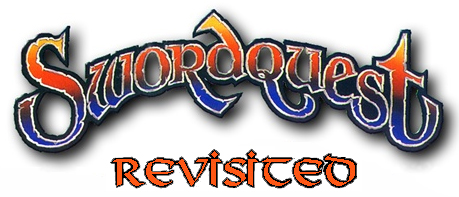
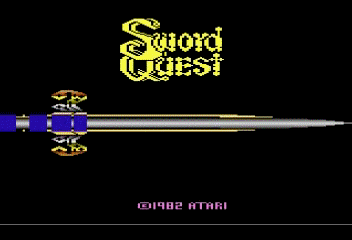
The SwordQuest Challenge was conceived solely by Tod R. Frye, and originally was called the Adventure Series. It encompasses 4 separate games: EarthWorld, FireWorld, WaterWorld, and AirWorld, which each game having its own contest. The prizes were valued at $25,000 (although the first 2 were worth a bit less at the time they were awarded).

Prizes: EarthWorld Talisman; FireWorld Chalice; WaterWorld Crown; AirWorld Philosopher’s Stone; Sword of Ultimate Sorcery
The Talisman was made of 18K solid gold and studded with 12 diamonds and the birthstones of the 12 zodiac signs.
The Chalice was made of platinum and gold and adorned with rubies, sapphires, diamonds, pearls, citrines and green jade.
The Crown was made of gold and encrusted with diamonds, rubies, sapphires, green tourmalines, and aquamarines.
The Philosopher's Stone was a large piece of white jade, encased in an 18K gold box featuring emeralds, rubies, diamonds, and citrines.
The Sword of Ultimate Sorcery was a silver blade with an 18K gold handle that was loaded with diamonds, emeralds, rubies, and sapphires.
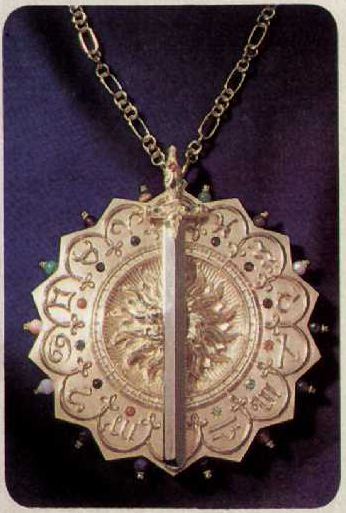
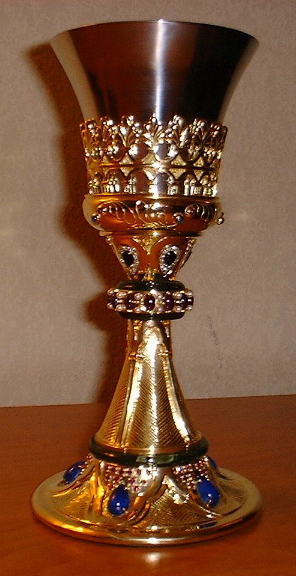

Actual photos of the Talisman, Chalice, and Sword of Ultimate Sorcery
The series was to culminate in 1984 with the winner from each of the 4 contests facing off for the grand prize: the $50,000 SwordQuest Sword. From Howard Scott Warshaw:
| “Steve Wright and I were driving back from a brainstorming session in Monterey. Warner had just bought D.C. Comics and we were going back-and-forth talking about getting a comic book series tie-in with D.C. Tod Frye did all the designs, with the four elements and how to tie everything together, which added up to about $200k worth of code! It was a cool concept, but early on though I felt that it wouldn’t come together the way we imagined.” |
From Tod Frye:
| Howard and Steve did have some ideas about using DC comics in conjunction with carts, but the Franklin Mint / DC Comics / Atari games 'triad' was conceived by me. The whole story line of mystic systems and 'grail quest' were solely conceived by me. |
The following information comes from Keith Smith's The Golden Age Arcade Historian website and is an excerpt of an interview with D.C. artist Roy Thomas in Alter Ego #100:
| Then came Swordquest. Gerry Conway and I came up again and huddled with a couple of Atari’s engineers. The company had this general idea for a series of four interconnected games under the banner 'Swordquest', with a grand prize they’d promote to help sell it. A sword was to be buried somewhere in the United States, and the person who found it – working from clues that were to be imbedded in the games themselves – would get a
considerable amount of money. This was based on a similar gimmick that we were told had recently been used by a book company, with clues hidden in some picture book; that had sent people scrambling all over the country in search of a buried treasure. Gerry and I immediately came up with the idea that the four games should be based on the four classical 'elements' – earth, air, fire, and water. It was basically a rather effete sword and sorcery comic – Atari wouldn’t have
wanted any real blood-and-guts – and
George Pérez was assigned to pencil the accompanying comics, which would again be printed in a pocket size. Gerry and I split the work on this one, but I forget exactly who wrote what. Only thing is, as I recall, before we did the fourth comic, a real problem arose with the earlier treasure hunt thing. We were told there were lawsuits in the case of the earlier book because some overeager people hunting for the treasure were digging up people’s lawns and demolishing property. So Atari pulled the plug on the Swordquest game before it got completed. Well, the comic book was a lot better than the game anyway. |
The book company mentioned was Jonathan Cape Ltd. (of London) and the book in question was Masquerade. It was first released in August 1979; the first American edition was released in January 1980 by Schocken Books. It was a picture book both written and illustrated by Kit Williams. It contained clues that led to a location in Britain of a jeweled golden hare that Williams created and buried. The treasure was found in March 1982 by Dugald Thompson, but he didn't find it by solving the the puzzle but rather from inside information as to the treasure's location.
Although the first issue of Atari Age mentions buried treasure being involved with the contest, I certainly can't imagine Atari actually burying a $50,000 sword somewhere. How could such a plan even conceivably work? Bring all the individual game winners to a specific location and have them run around with shovels? Also, Atari didn't drop the contest to avoid any potential lawsuits in regards to burying the sword, but rather because the crash forced Warner Communications to sell Atari, and the new owner, Jack Tramiel, wanted nothing to do with honoring the contest, or with video games in general.
Each game represented one of the 4 Symbols of Astrology:
Earth (directed will - energy radiating out from the center; action)
Fire (physical - force that holds the atoms together; practical applications; consolidation)
Water (intellect; the energy that shapes the pattern of things to come; communication)
Air (soul, emotions; power of the unconscious mind; connecting to the source; reception).
Atari hired marketing firm Amrein Marketing Associates, Ltd. to handle the SwordQuest contest. All contest entry forms were to be mailed to P.O. Box 8902, Westport, CT 06888. The series was heavily promoted by Atari, and the first game, EarthWorld, was released in October 1982.
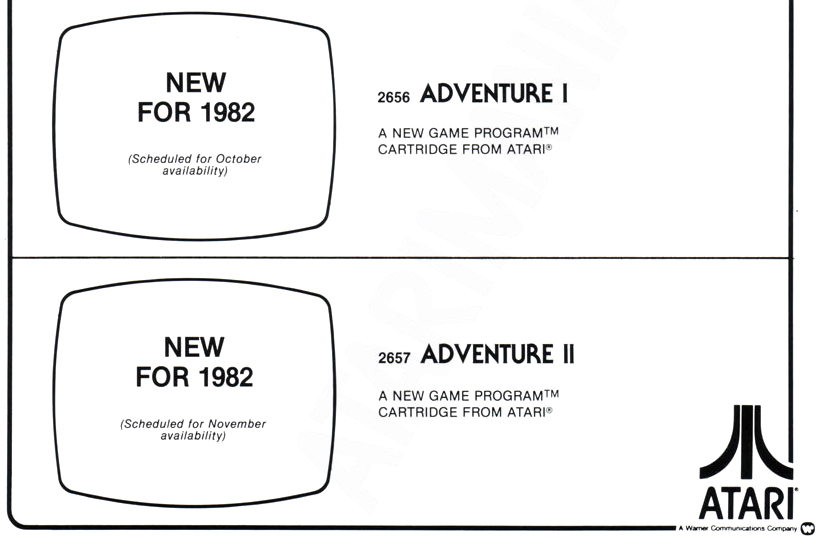
Announcement from an Atari 1981 Canadian brochure
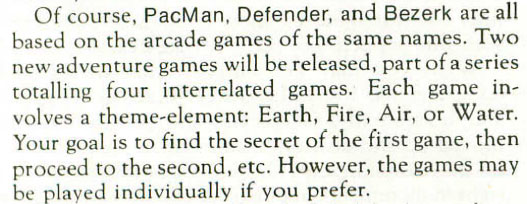
A.N.A.L.O.G. announcement, January 1982

An early SwordQuest title screen of Mimi Doggett's that was found in Jerome Domurat's archives, dated 4-15-1982.
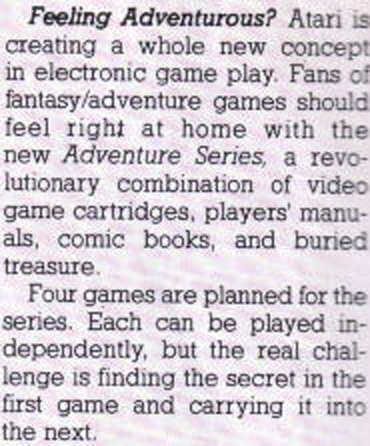
Atari Age announcement, May/June 1982

A.N.A.L.O.G. announcement, September 1982
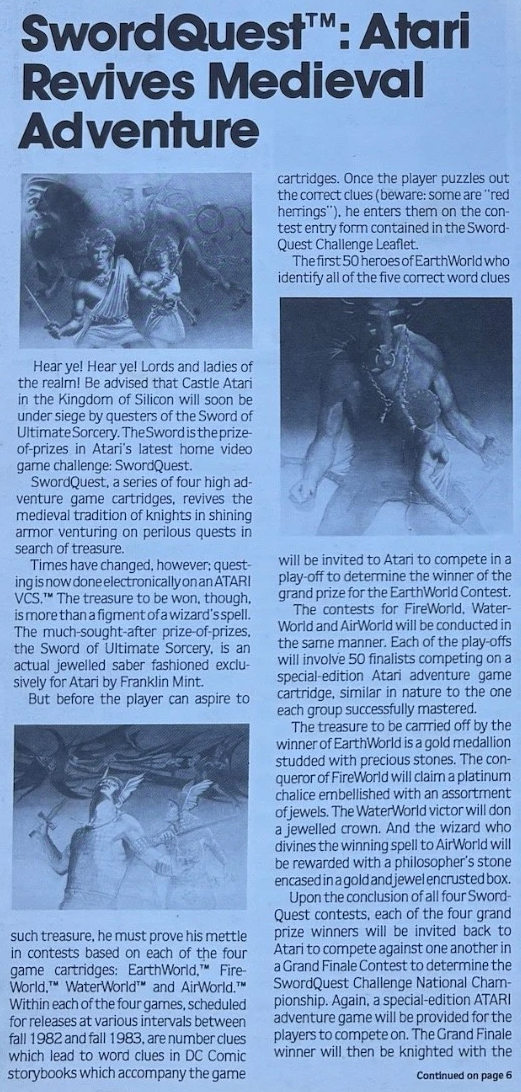

Atari Life article, V1N9 (September 1982)
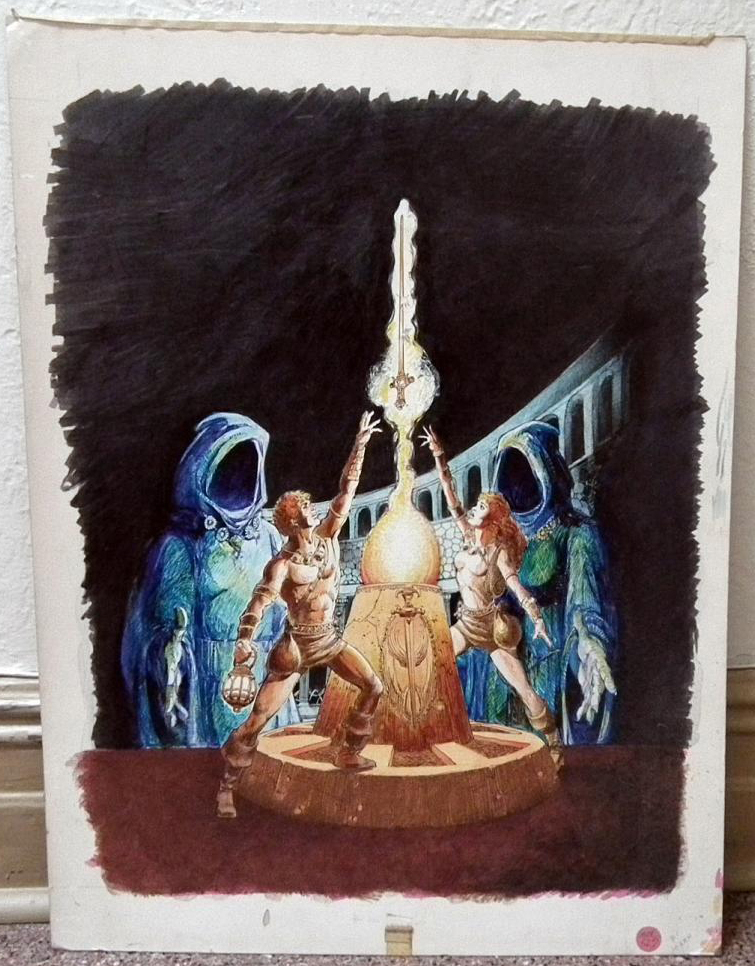
Famed comic artist
George Pérez created this original artwork for the cover of the Sept/Oct 1982 V1N3 issue of Atari Age.
Atari Age founder and editor
Steve Morgenstern was in possession of this, and after his passing it was
auctioned off on Ebay on April 12th, 2014 for $2,672, which ironically, is the same as the CX number for AirWorld.
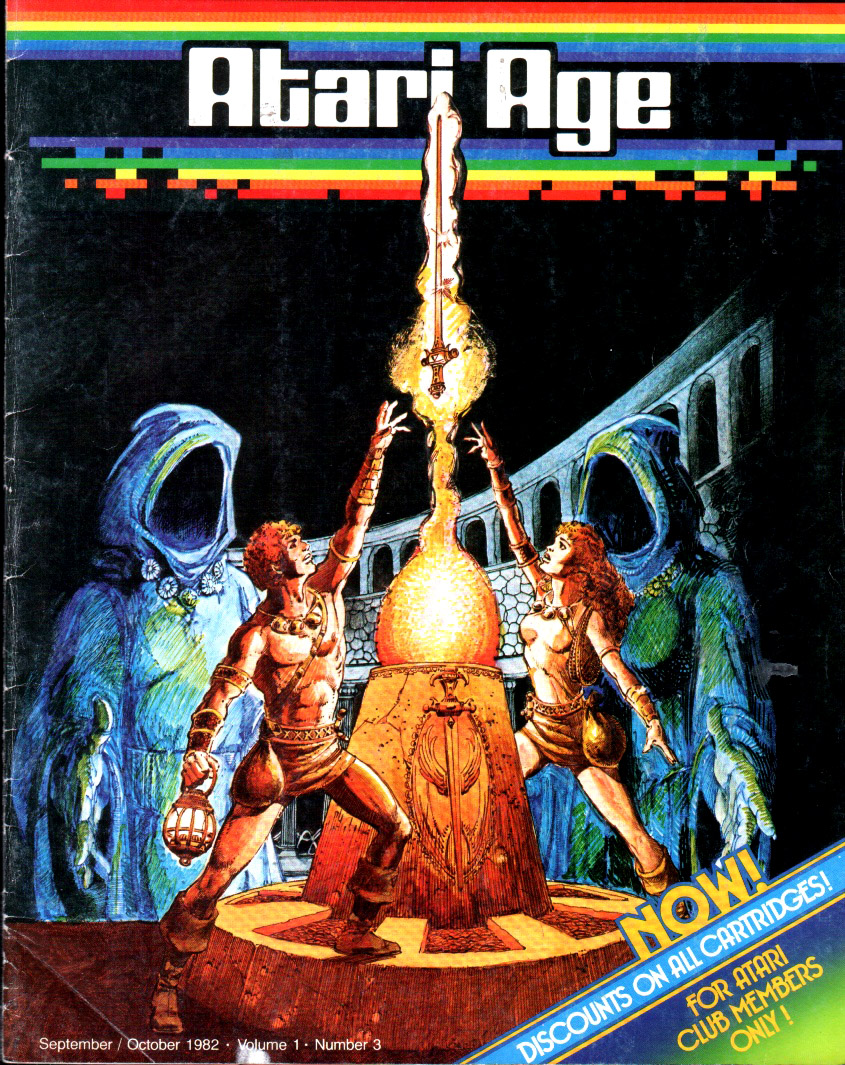
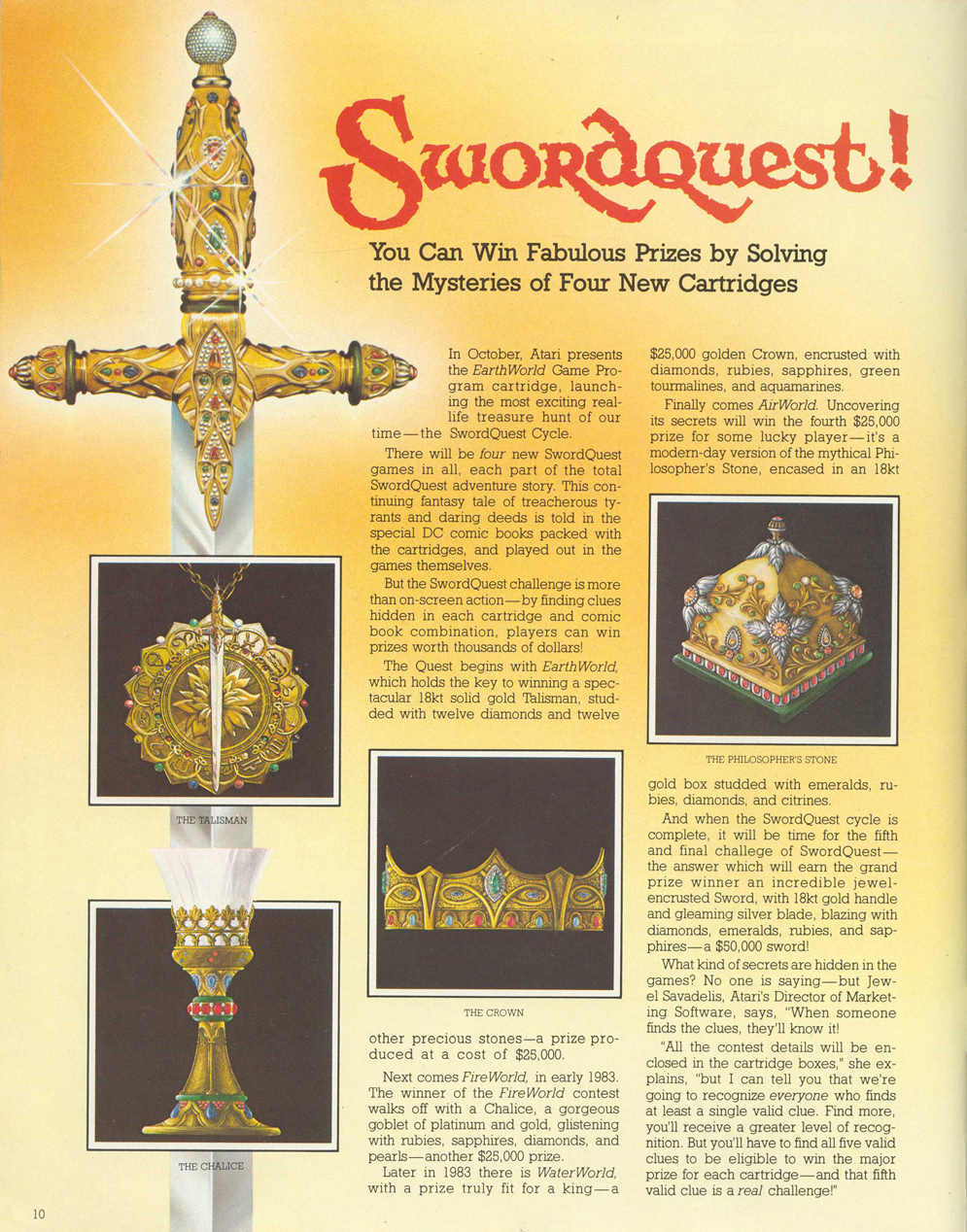
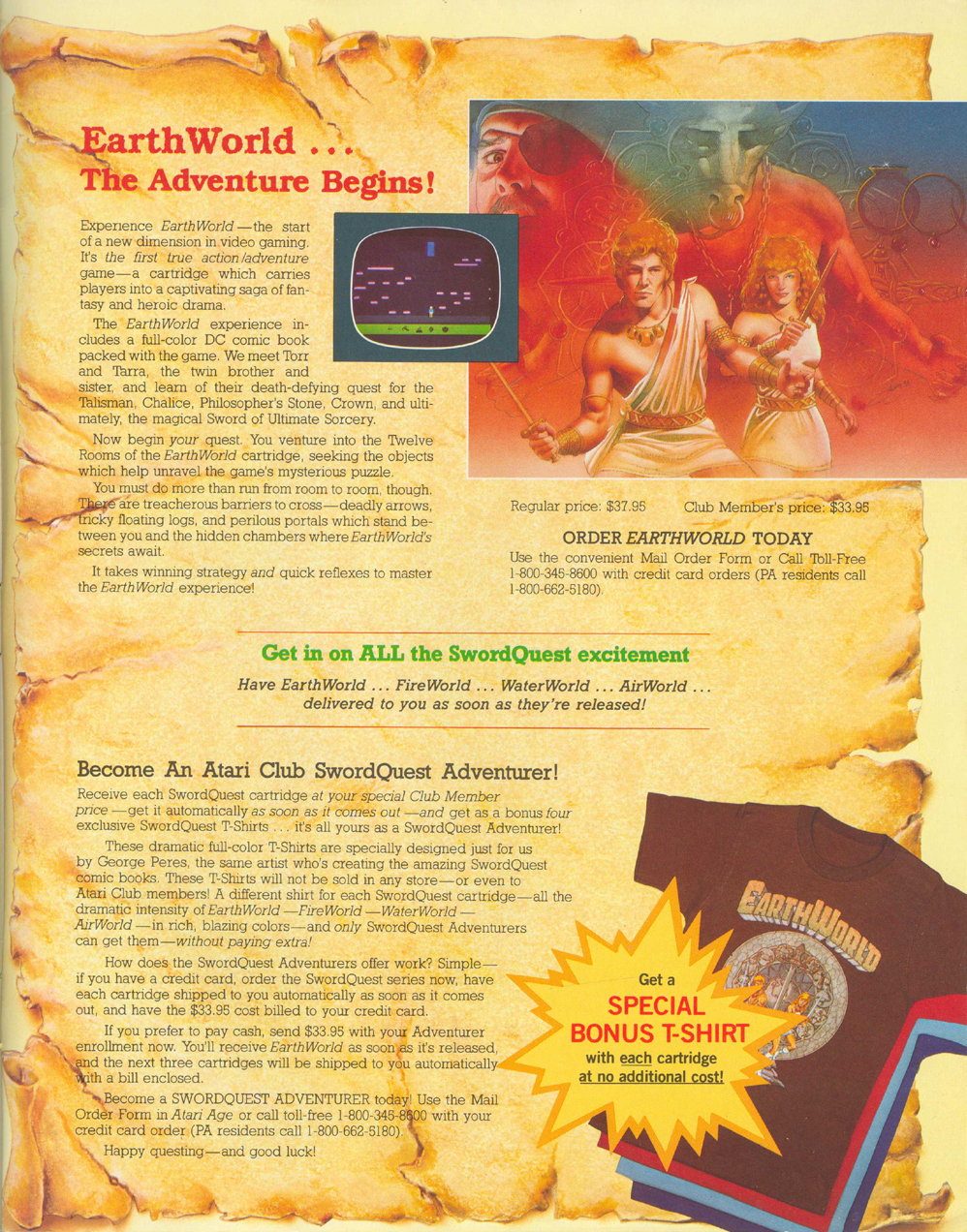
Atari Age official announcement, from the Sept/Oct 1982 V1N3 issue. Note that T-shirts for all 4 games are shown.
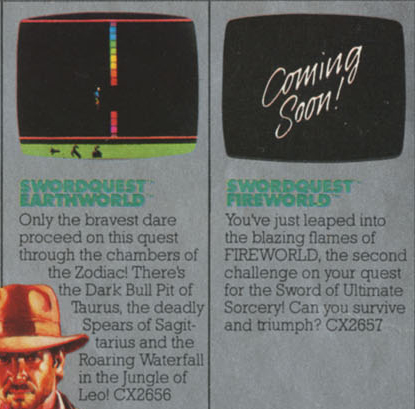
1983 "ATARI GAME CATALOG: YOUR TICKET TO THE ATARI STARS” Rev A catalog entries.
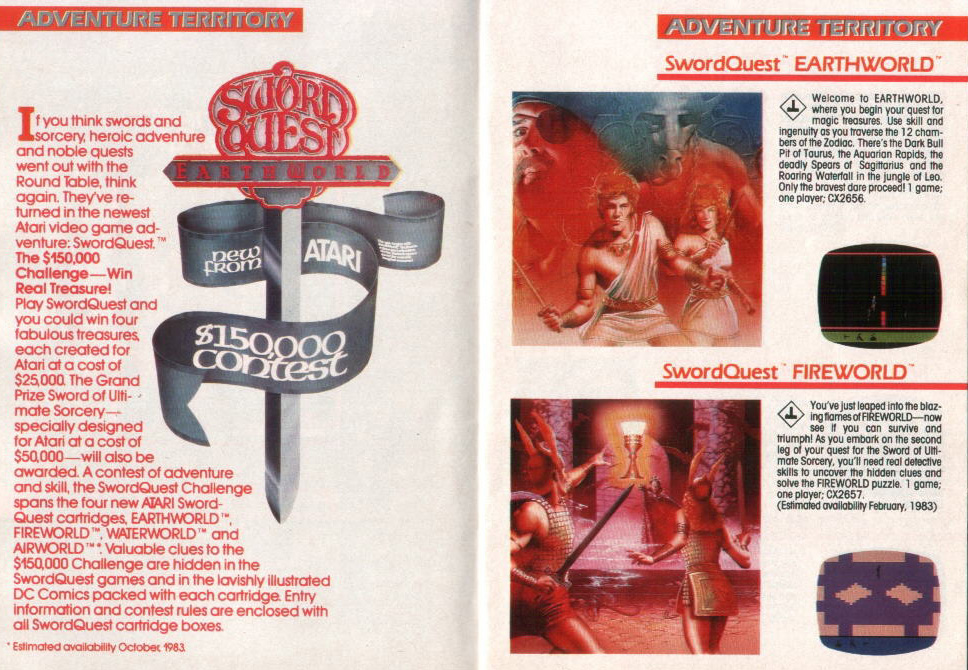
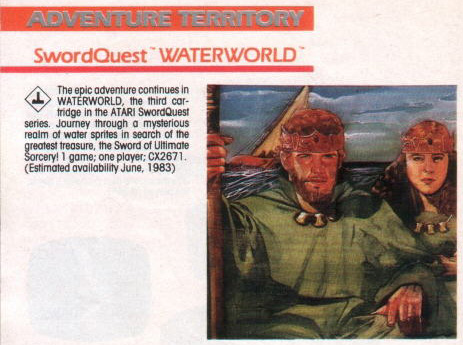
1982 “A GUIDE TO THE ATARI STARS" Rev F catalog entries. Note early artwork for WaterWorld.
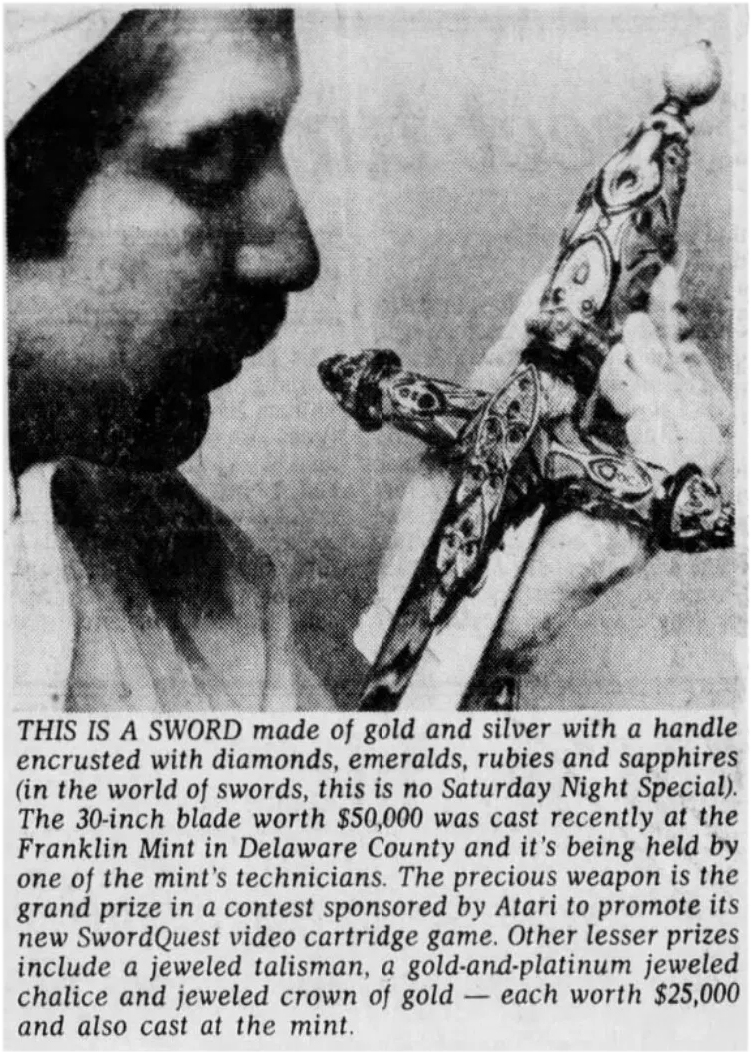
The Philadelphia Inquirer newspaper article, dated October 4th, 1982.
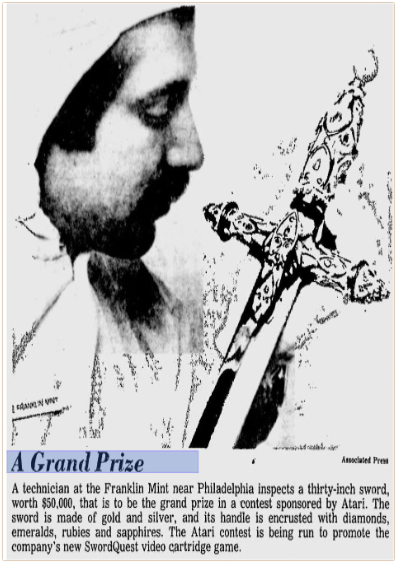
Observer-Reporter newspaper article, dated October 5th, 1982.
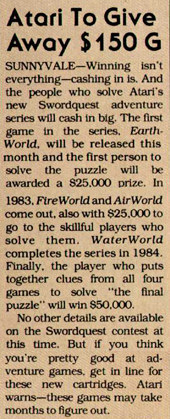
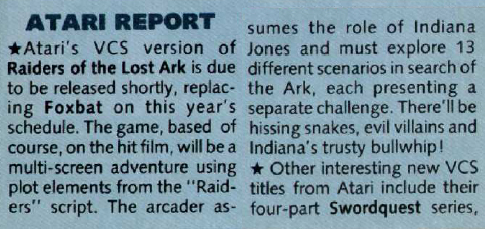
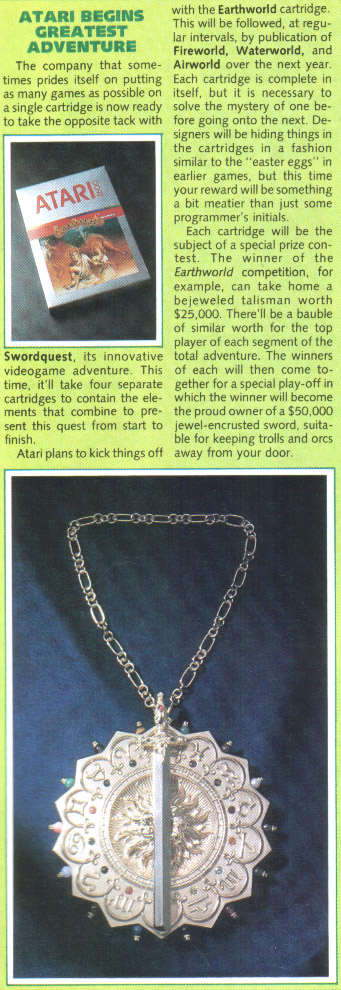
Electronic Games blurb, November 1982; announcement, December 1982
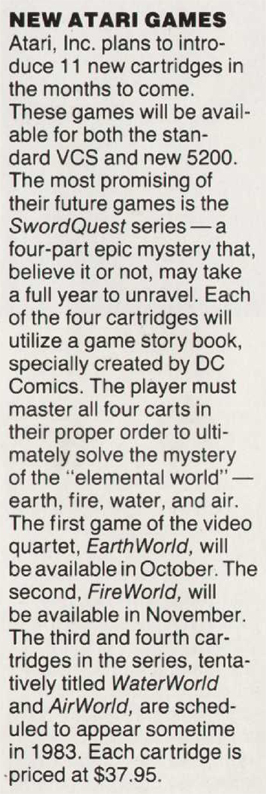
JoyStik announcement, November 1982
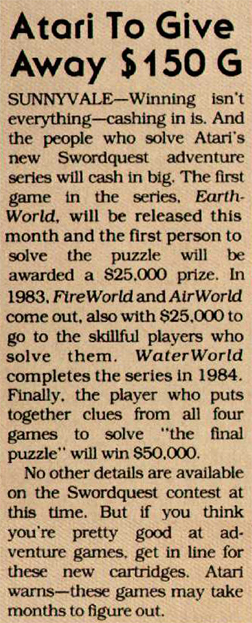
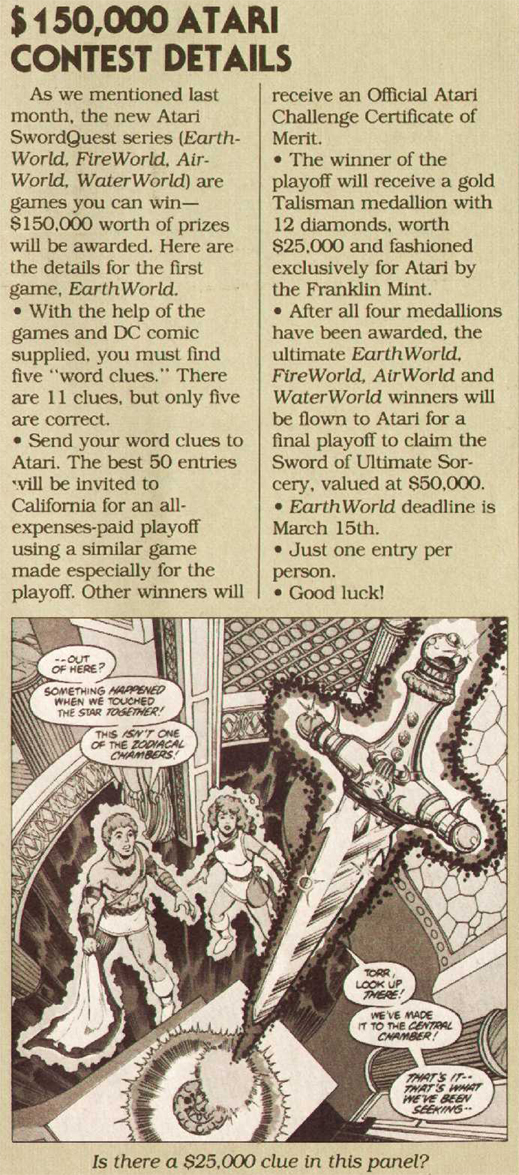
Electronic Fun announcements, November and December 1982
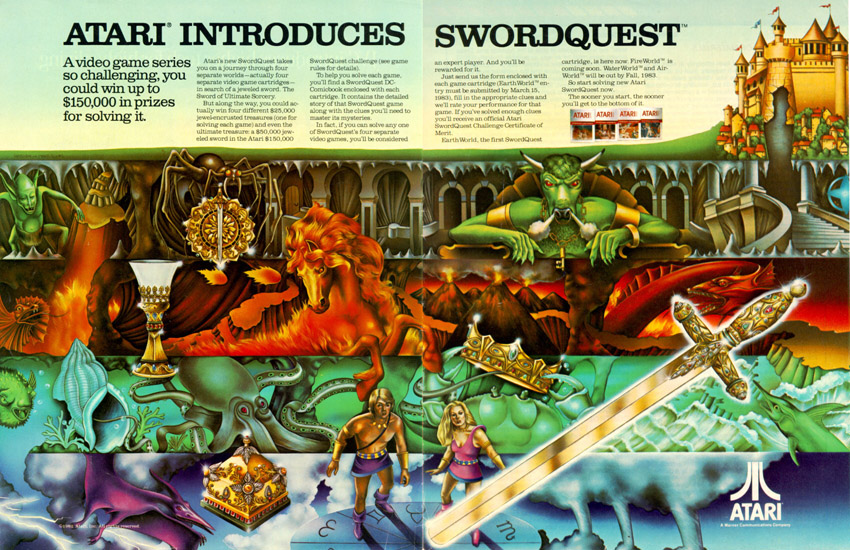
Magazine ad. First shown in the December 1982 issue of Electronic Fun and later in the January 1983 issues of Electronic Games and Video Games.
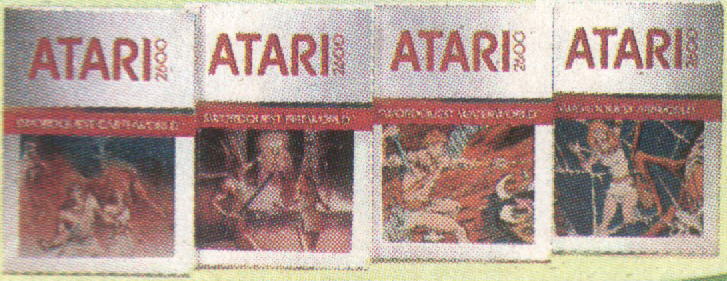
Close-up of boxes from above ad. Note the different artwork for WaterWorld and AirWorld.
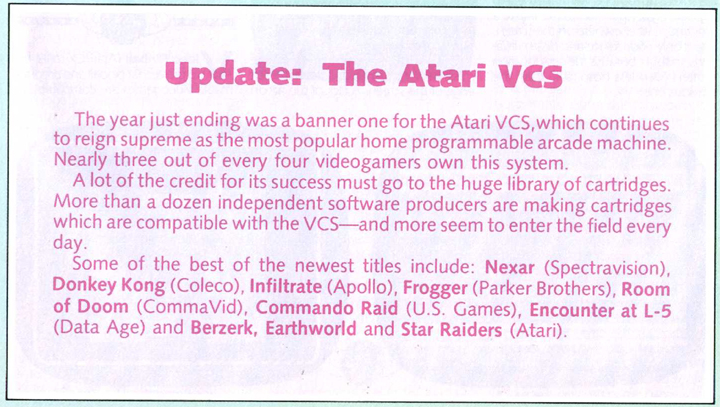
Electronic Games blurb, 1983 Buyer's Guide issue.

Electronic Games Certificate of Merit, January 1983. Ironic, since the only reviews EG did were in their 1984 Software Encyclopedia.

EarthWorld pamphlet
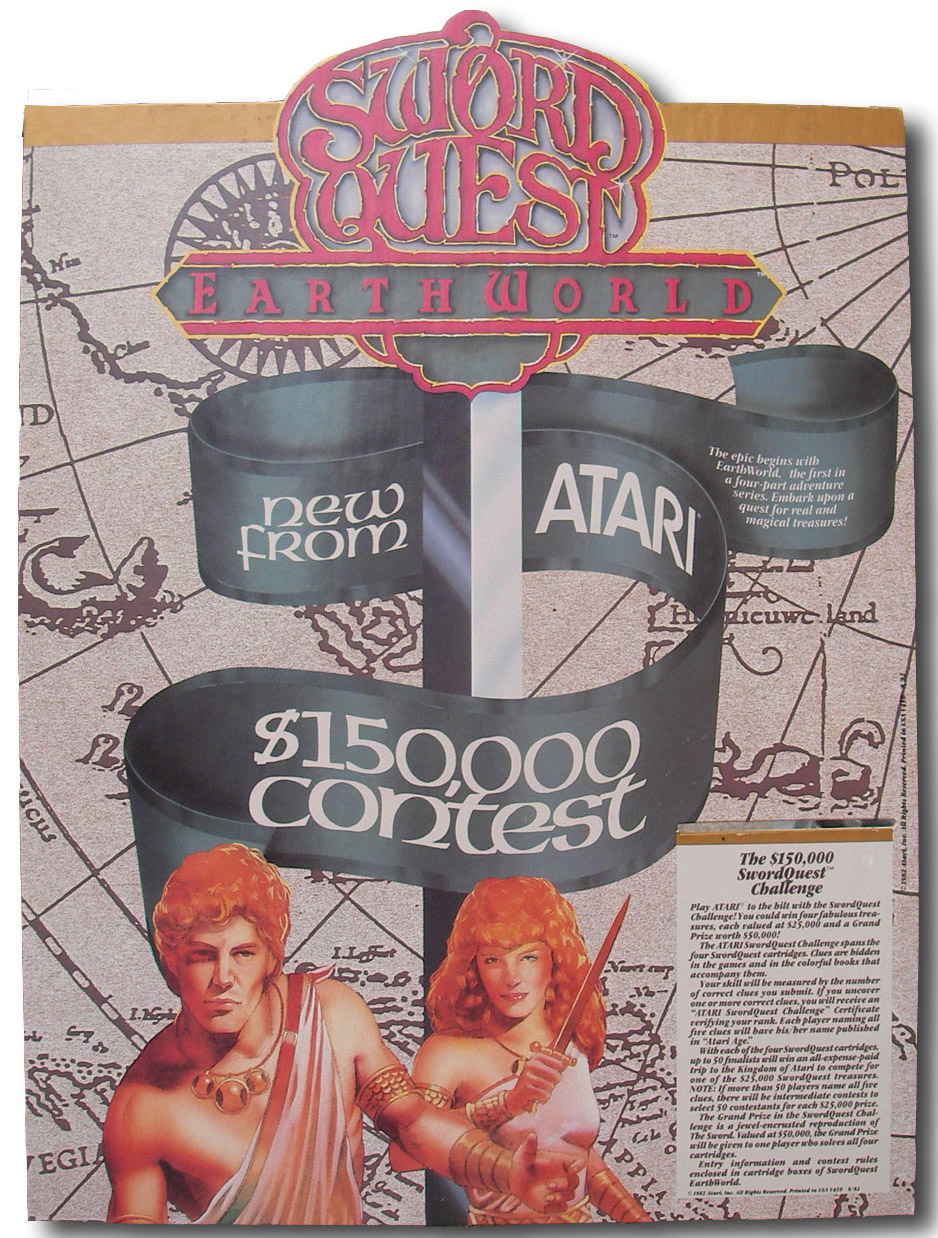
Atari store display
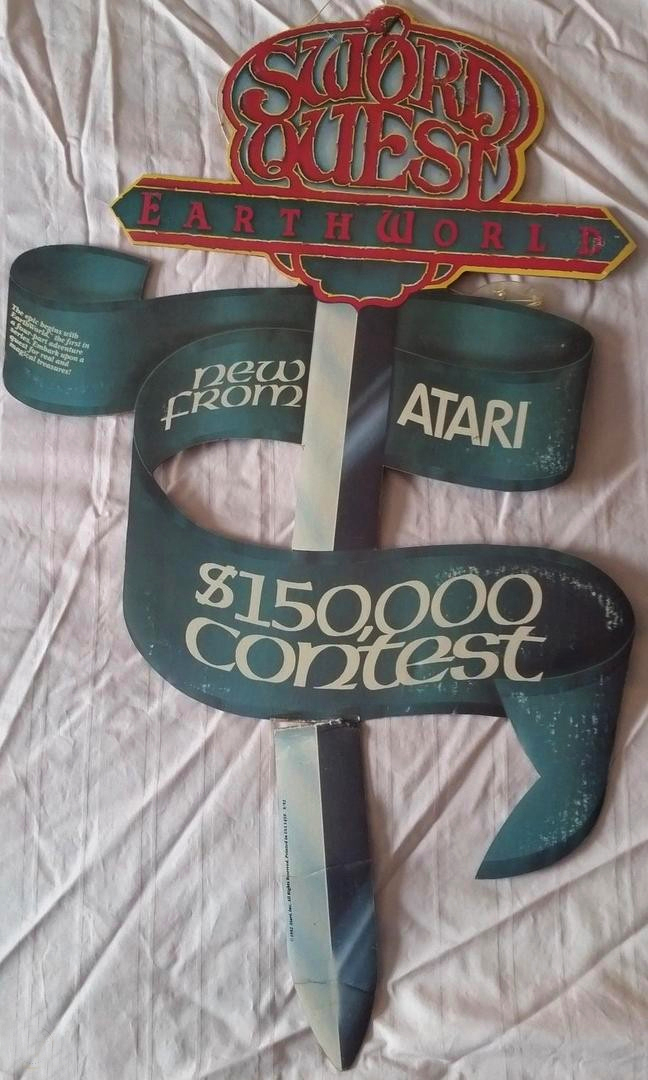
Atari dealer display
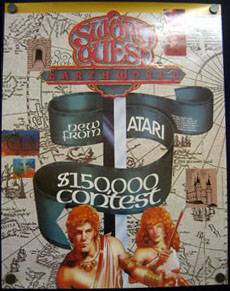
Atari contest poster
This episode of Bob Sarlatte's American Hot Stuff briefly covers SwordQuest EarthWorld.
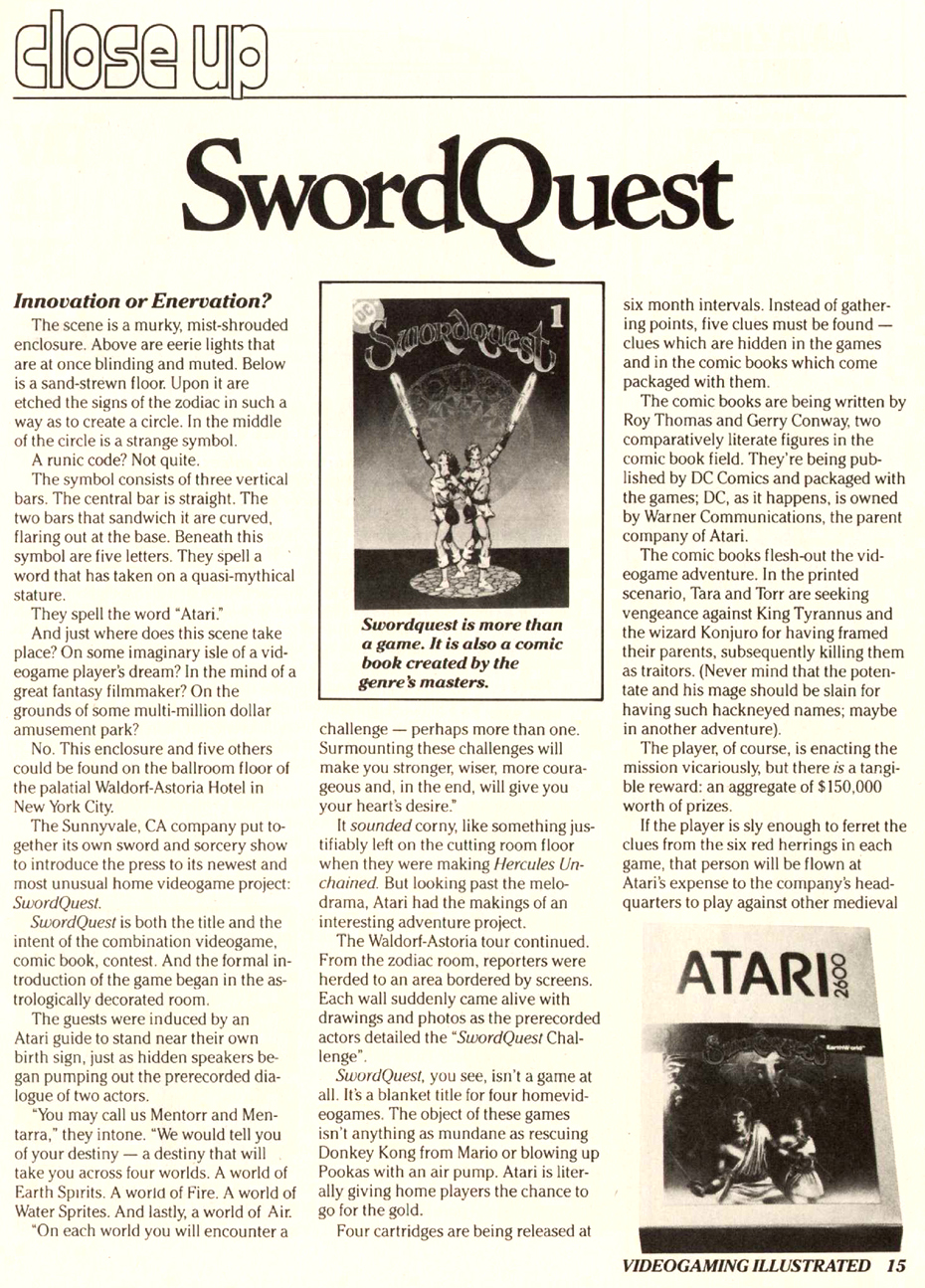
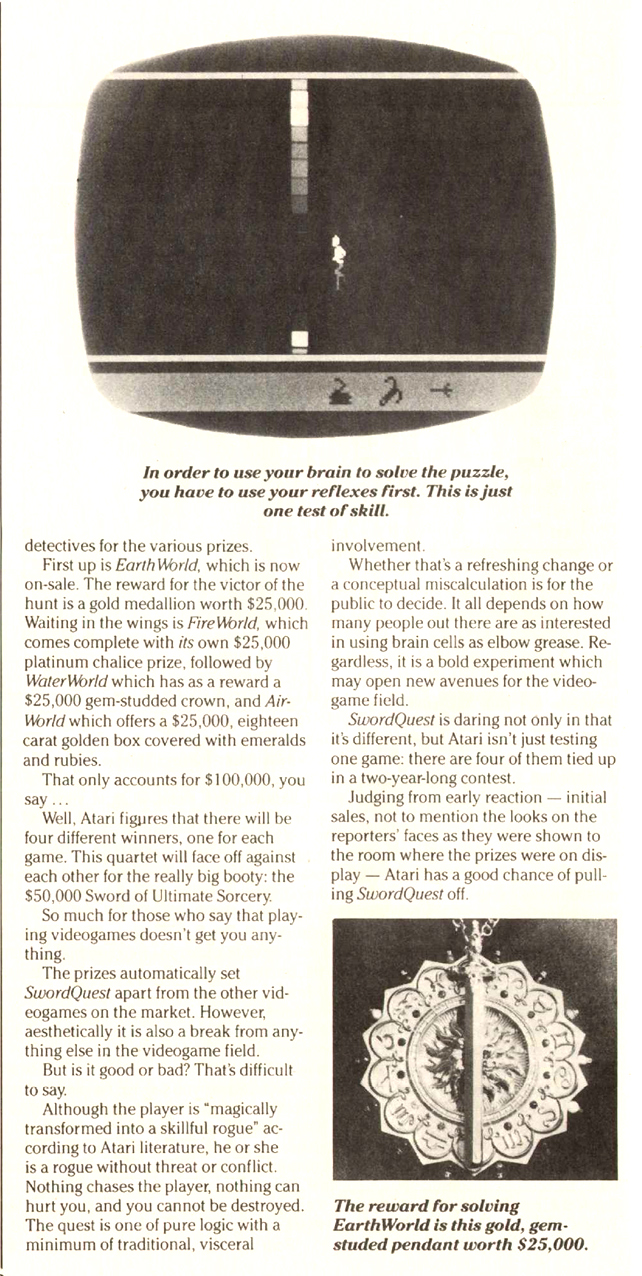
Article in the February 1983 issue of
Videogaming Illustrated
(pg. 15,16)
about Atari's press conference
at the NY Waldorf-Astoria hotel to announce the SwordQuest contest.
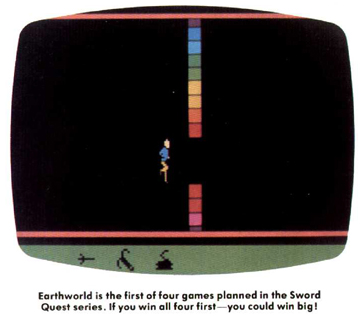
Vidiot blurb, February/March 1983

SwordQuest EarthWorld
Programmed by Dan Hitchens
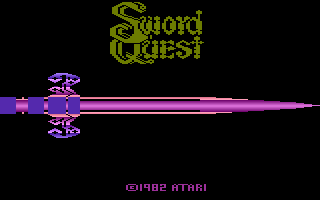
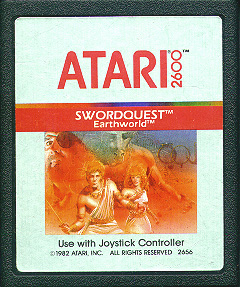
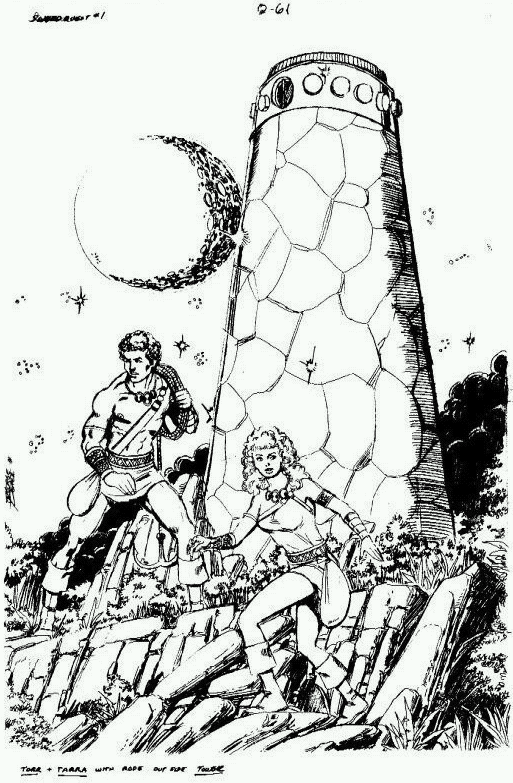
Early comic cover art by George Pérez
Gaming notes
† The game was coded by Dan Hitchens, under the design direction of Tod Frye, and was released October 1982.
† The band of the sky in which the planets move is called the Zodiac, which is divided into 12 Signs (each sign represents a specific energy pattern or mode of expression, and contains 30 degrees, or 1/12th of a circle). Together they comprise the 4 basic Elements, and each act in ways, or modes. Each group of 3 Signs of the same element is called a Triplicity, and each group of 4 Signs of the same mode is called a Quadruplicity. The game is based upon these Signs, and the rooms are laid out in a circular pattern for this reason.
† Going left 1 room is equivalent to going up 4 rooms (clockwise on the Zodiac “wheel”); going right 1 room is equivalent to going down 4 rooms (counter-clockwise). Michael Rideout noticed that by using the left and right exits, you can see how the layout also incorporates the Triplicity groups:
Taurus – Virgo – Capricorn denote Earth
Aries – Leo – Sagittarius denote Fire
Cancer – Scorpio – Pisces denote Water
Gemini – Libra – Aquarius denote Air.
The comic book further illustrates the significance of the Zodiac. Each Zodiac “room” has a corresponding House (there are 12 Houses in Astrology, and each House has a planet which is its natural ruler), and the main characters eventually cross paths with all the rulers of each House.
† It’s possible to run through all the different waterfalls (in Leo) without stopping.
† There are invisible “lines” running vertically down the screen that (when crossed) trigger the next waterfall, or the entrance to the zodiac room. Notice that the waterfalls slowly move to the left. If you let one (the first one is the most difficult since there’s little room to maneuver) of them pass w/o triggering the next line, it will eventually wrap-around the screen!
PAL version notes
† Although the boxes and labels have a 1982 copyright date on them, it would seem the PAL version wasn't released until 1985 at the earliest. In the Winter 1983 issue of (London-based) TV Gamer (pg. 12, 14), the Club News section twice states the first two SwordQuest Games are not available, and even mentions a representative from Atari told the magazine "they're not the best adventure games they've designed." Truer words have never been spoken.
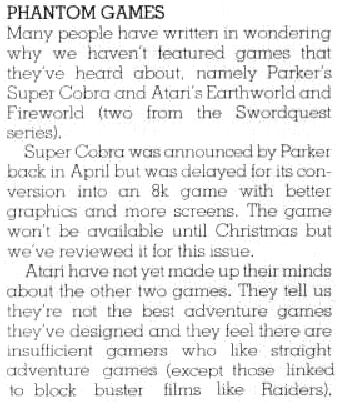 |
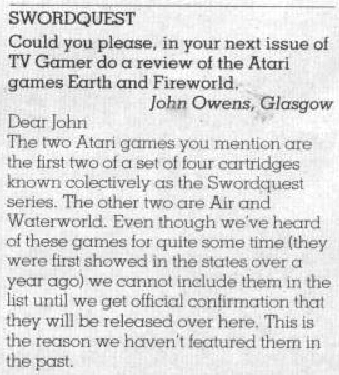 |
In the September 1984 issue of TV Gamer (pg. 64), someone again asked if the SwordQuest games would be released there. There was no comic book, poster, contest entry form, or contest sticker on the box, as the contest was only promoted in the U.S. (this is likely why the game's solution is different). Atari Bénélux (who were the subsidiary of Atari located the Netherlands) promised there would be a contest when they released the games, but that never happened. The Dutch manual supplement from Atari Benelux apparently has a 1983 copyright on it.
† The PAL version has a different solution. Instead of getting numerical clues that refer to panels in the comic book, you simply get a number from 1 to 11. Luc Pycke obtained a fax from Atari Bénélux (who obtained it from Atari International) containing the solution, which was supposedly hand-written by Dan Hitchens. The solution does have a few errors - #5 and #10 were incorrect. The correct solution appears below, along with a copy of the fax.
† The inventory bar/strip actually extends to the very bottom of the screen, unlike the NTSC version. Also, each clue gives a bit more of the EarthWorld “fan fare” (as mentioned in the manual), rather than different tunes for each, as in the NTSC version.
† It’s interesting to note that there are only 11 levels, since the game is based around the 12 Zodiac symbols. Perhaps there is a yet-unfound 12th clue?
|
EarthWorld PAL solution
|
Hand-written EarthWorld PAL
solution note |

PAL end label
Contest notes
† The deadline for entering the contest was March 15, 1983. Atari CED Product Manager Joel Oberman claimed more than half a million EarthWorld cartridges were sold in the U.S., and of those, only 1% - 5,000 - were semi-finalists; according to Robert Ruiz Jr., over 4,000 entered the contest. Of those, only 8 had the correct solution - "QUEST IN TOWER TALISMAN FOUND". Here is the list of the finalists, along with their ages and then-locations:
Matthew Balasa, 21, Bayshore, MI
Steven Bell, 20, MI (either St. Clair or St. Clair Shores) - the eventual winner
Jacquie Custer, 30, Arleta, CA
Stephen Perry Doussa, 18, Arabi, LA
Douglas Ferry, 18, Chalmette, LA
John D. Hoffman, 30, Waterloo, NY - absent from contest (missed his flight)
Thomas J. Neill (or Heil?), 32, Clairton, PA
James Schweitzer, 16, No. Charleston, SC
† At least 7, possibly 8, special edition “championship” carts were made. The championship was held on May 2, 1983 at Atari’s headquarters in Sunnyvale, CA. The contest had a 90-minute time limit. Steven Bell finished the game in 46 minutes, 49.4 seconds.
† It was long believed the PAL version was the same “Special Edition” version used for the contest, since it was mentioned that the contest version comprised 11 “levels” of play, but this is not the case. John-Michael Battaglia, who was a writer at Atari, kept a copy of the EarthWorld Playoff Contest Rules, along with programmer Dan Hitchen's handwritten notes for the solution to the contest version (seen below). John-Michael Battaglia had this to say about the SwordQuest contest:
| I was a Senior Copywriter at Atari in the early days of the video game industry. I wrote instruction manuals and packaging copy for several Atari 2600 and Atari 5200 video games. I also worked on special projects, like the Atari Swordquest Challenge, around the same time that I was writing the manual for WaterWorld, one of the games in the four-part SwordQuest series. For one of the four playoff competitions in the Atari SwordQuest Challenge, I had all of two days to come up with a way to allow a half-dozen contestants to compete in a race to get through all the levels of EarthWorld, a brute-force adventure game that had required gamers to spend weeks of their lives trying to figure out the astronomical permutations regarding which 16 magical objects needed to go into which 12 rooms of the Zodiac at various points in their quest for a magical sword. Atari had sold over 500,000 of these games in a gigantic cross promotion involving DC Comics and the Franklin Mint, and, without clues to guide them through the adventure, only 7 people managed to get themselves invited to participate in the quarter-final playoff tournament. The playoff winner would walk off with a $25,000 prize, as well as earn a chance to compete in the final SwordQuest Challenge for a jewel-encrusted sword worth $50,000. Since all the rooms in Earthworld were named after the houses of the Zodiac, I wrote a series of arcane clues that directed the keenest reader among the contestants where to place the correct magical objects and race to victory within less than two hours. Essentially, I provided word-clues with an astrological theme to blend aspects of the game's key elements in the context of a puzzle based on the game's theme. As the participants later acknowledged, the arcane word-clues added a twist that elevated the original design of the game to a more entertaining level, while also making it possible for someone to actually solve the game/puzzle in time for the luncheon award ceremonies. I got a nice memo of appreciation from the product manager for making the playoff competition a success, and the whole episode was written up in Atari Life, the Atari employee newsletter. Of course, while it is not possible to play the limited edition playoff game that was programmed exclusively for the playoff, anyone wishing to try their luck deciphering the arcane clues can do so now by first getting very familiar with both the list of magical objects and the signs of the Zodiac. Your eye-hand coordination won't be tested like it was in the original game play, but at least you might have some fun trying to figure out what magical objects go into what astrological houses, based on the Earthworld play-off word-clues that I wrote for the playoff. Just don't expect a jewel-encrusted sword to be waiting for you if you succeed! The playoff winner navigated through the puzzle in less than an hour, leaving us all plenty of time to enjoy the luncheon ceremony that followed. How well can you do? |
† Here's a copy of the memo from Joel Oberman to John-Michael Battaglia, dated May 3, 1983.
† Here's a copy of the Atari Life magazine article. Note that Stephen Perry Doussa isn't listed as one of the finalists, but that John Hoffman is! Doussa was in fact in the photo and Hoffman was (later confirmed by Steven Bell below). Thomas Neill's last name is also incorrectly spelled as "Heil" and Steven Bell's hometown incorrectly identified as St. Clair Shore.
† John-Michael Battaglia was also in possession of a one-of-a-kind SwordQuest EarthWorld Sears-style manual, as well as a SwordQuest EarthWorld playoff contest prototype (see below). It's unknown what happened to it after his passing.
† It's long been rumored Steven Bell had the Talisman melted down for money, but in a 2024 podcast, Steven stated after winning it, he kept it in a safety deposit box for a few months, but ultimately sold it the following September because he couldn't afford the income tax on it. He took it to a local coin dealer, who offered him $14k. He went to another coin dealer who offered $15,600. He kept the small sword that was on it, for which the dealer valued at $800. The sword was stolen from him a few months later. Most of the money he got from selling the prize was spent on a 1984 Pontiac Fiero, but due to having multiple issues with it, he no longer had the car 4 years later. FYI - Steven claims Stephen Perry Doussa was at the contest and who ultimately was his closest competitor in the contest. Steven also claims the one person who didn't show up at the contest (John D. Hoffman) apparently missed his flight! An Atari Age article confirms Stephen Perry Doussa was Steven Bell's competition near the end, but an Atari Life article has a group photo of all the contestants, with John D. Hoffman incorrectly listed as one but Stephen Perry Doussa was not even though he was in the photo!
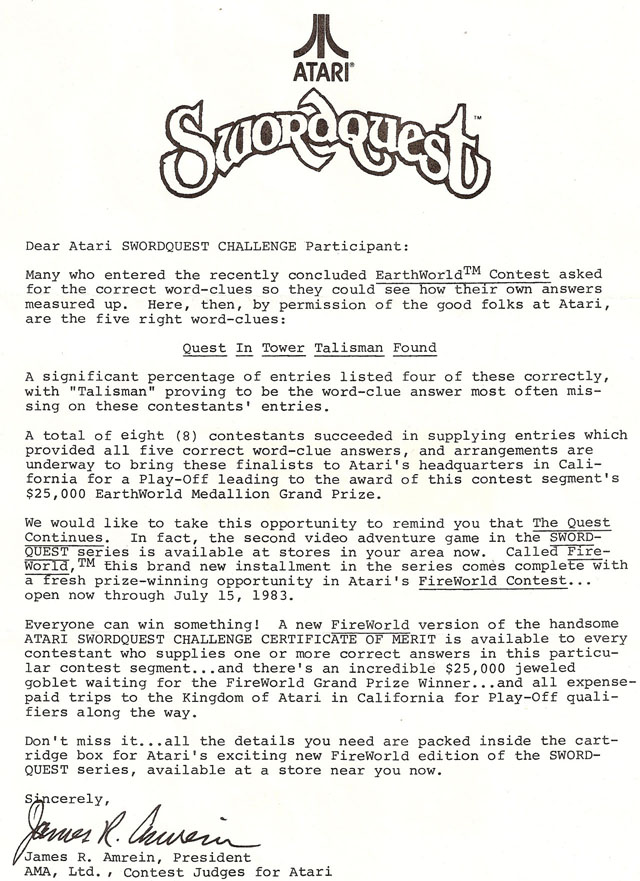
|
EarthWorld contest solution
|
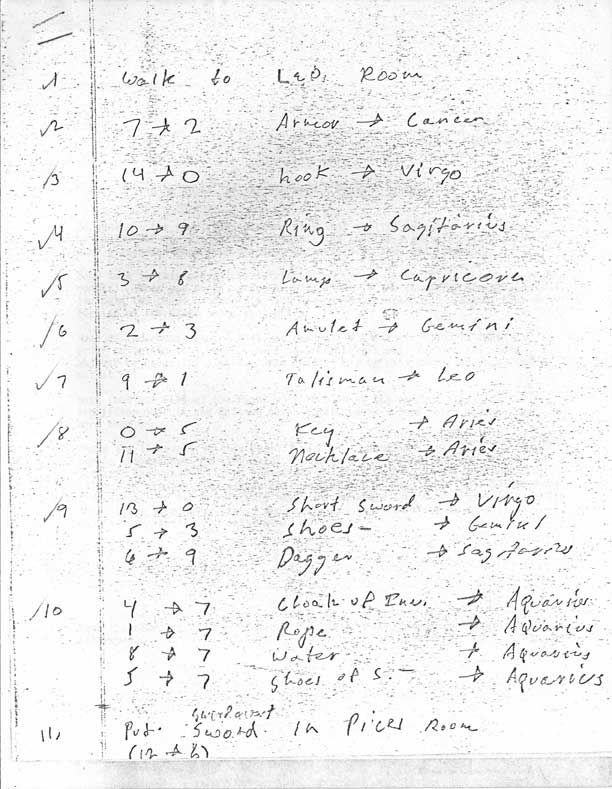 Dan Hitchen's handwritten notes for the solution to the contest version |

Video Games review, January 1983


Electronic Games Q&A, February 1983; Electronic Fun letter, June 1983
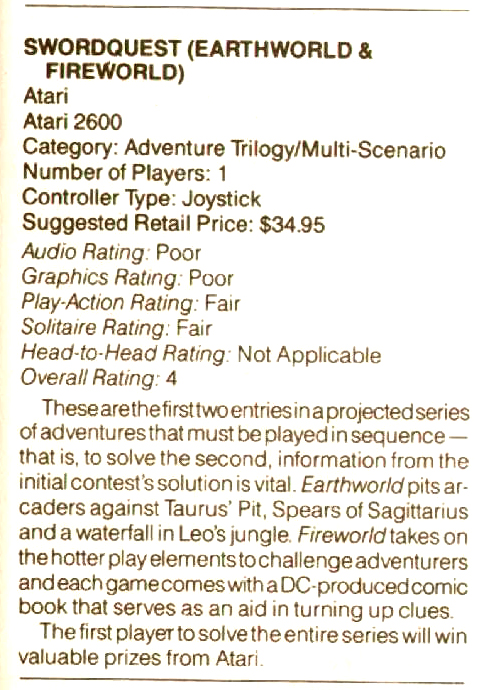
Electronic Games reviews, 1984 Software Encyclopedia issue. It's amazing how often EG's opinions changed within a year's time.
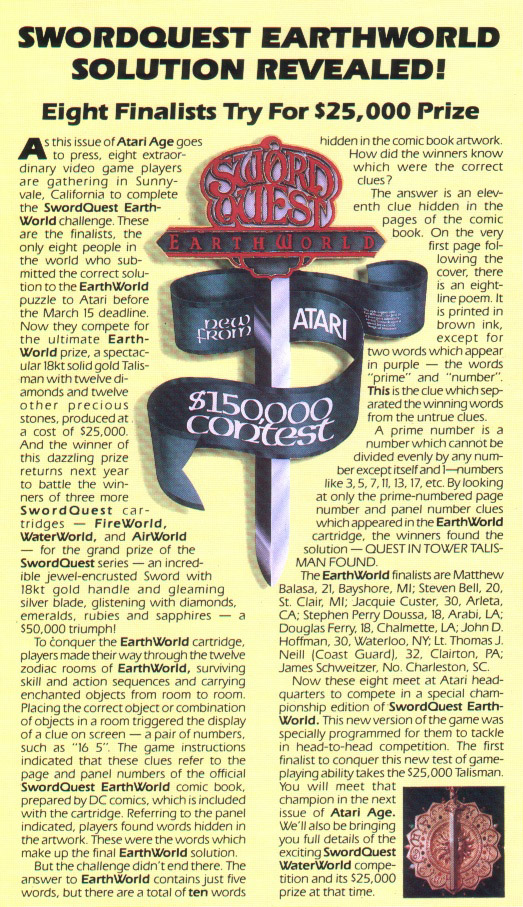
Atari Age EarthWorld contest finalists article, from the May/June 1983 V2N1 issue.
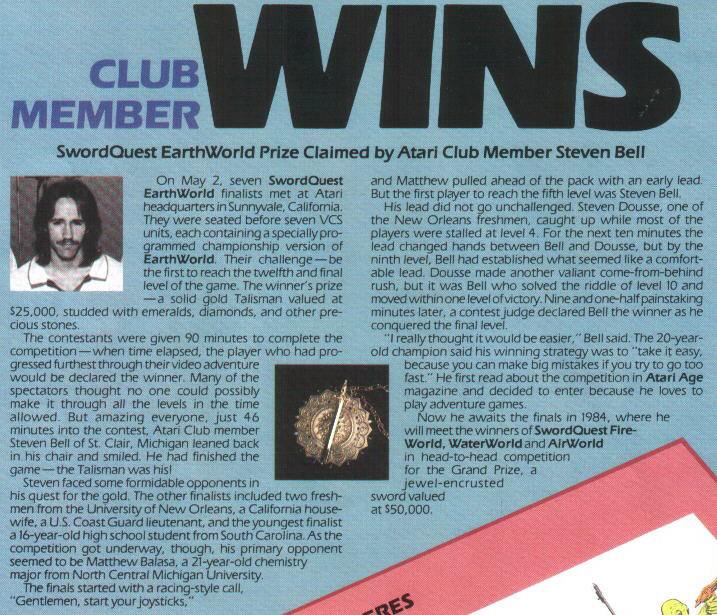
Atari Age EarthWorld winner announcements article, from the July/Aug 1983 V2N2 issue.
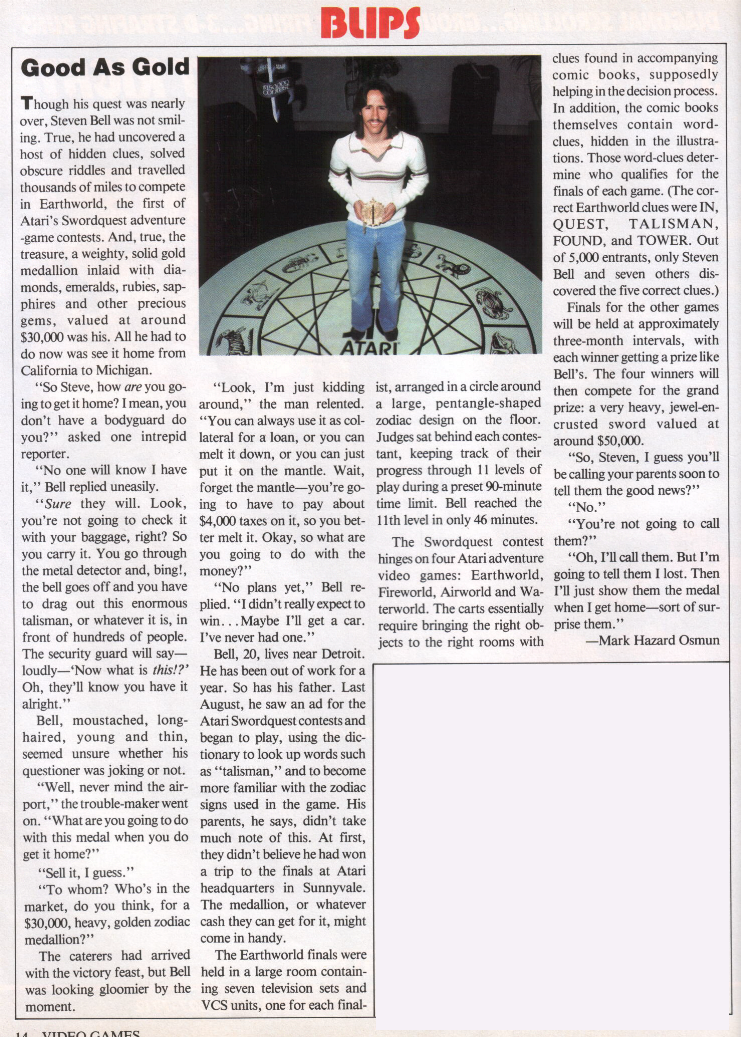
Video Games article, August 1983
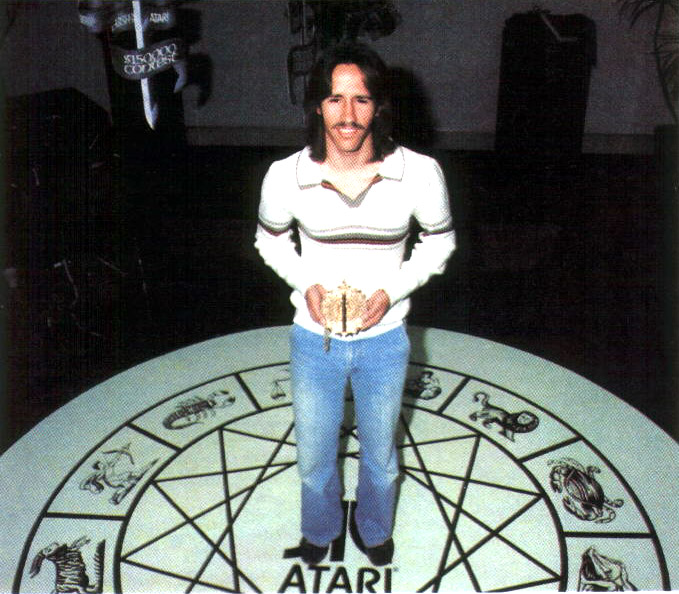
Close-up picture of the Atari Zodiac Mandala
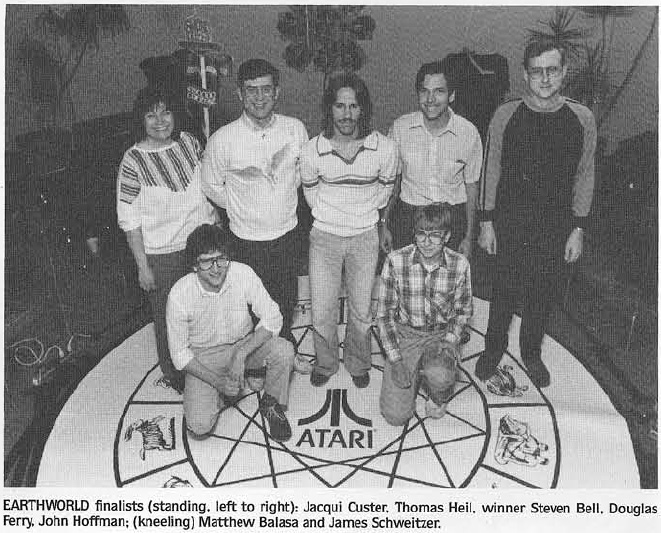
Photo of EarthWorld contest finalists from Atari Life, V2N10
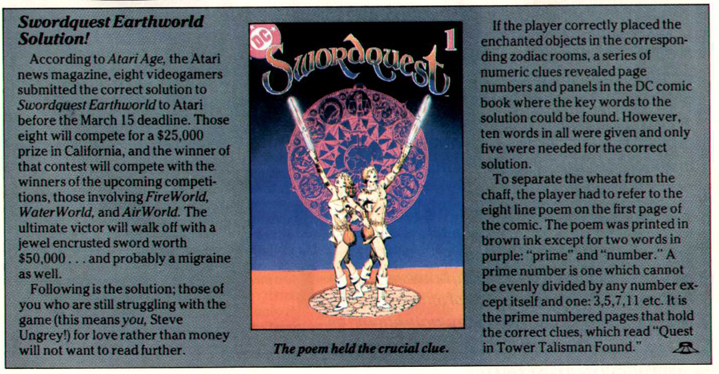
Videogaming Illustrated article, September 1983
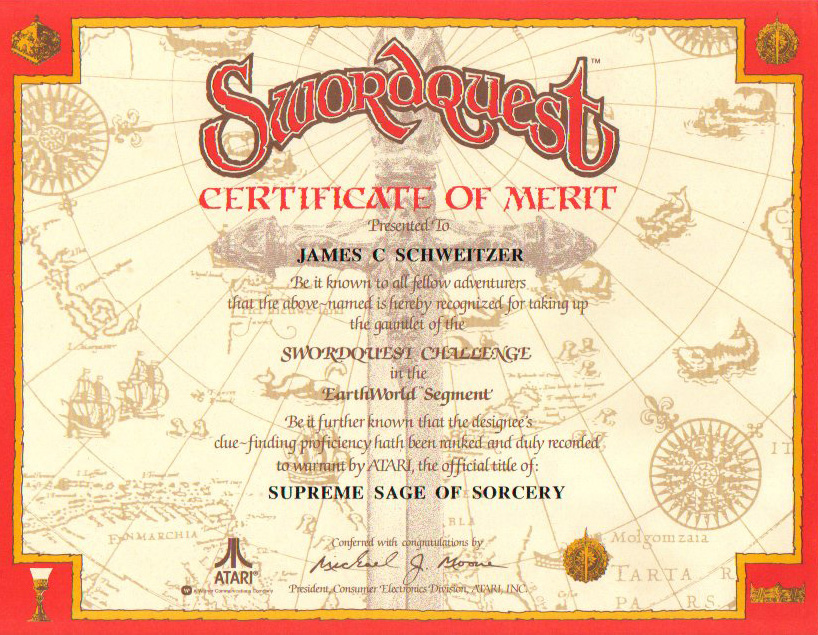
Certificate of Merit
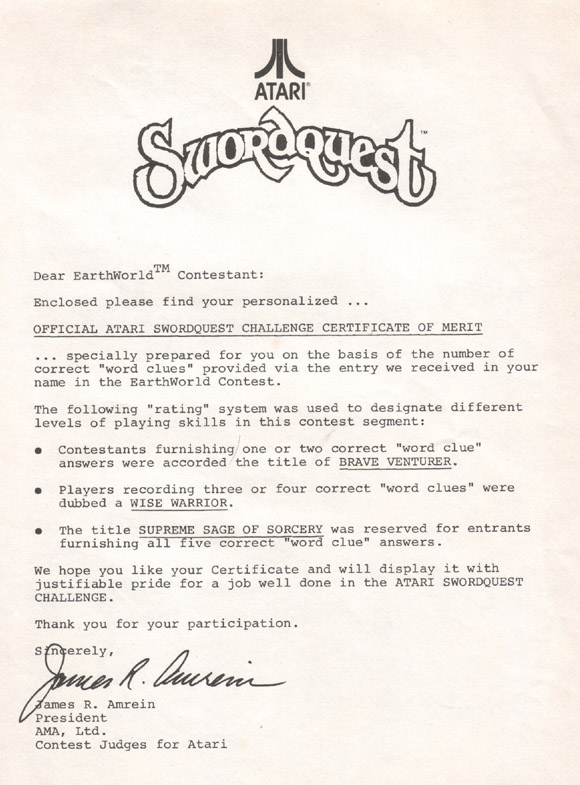
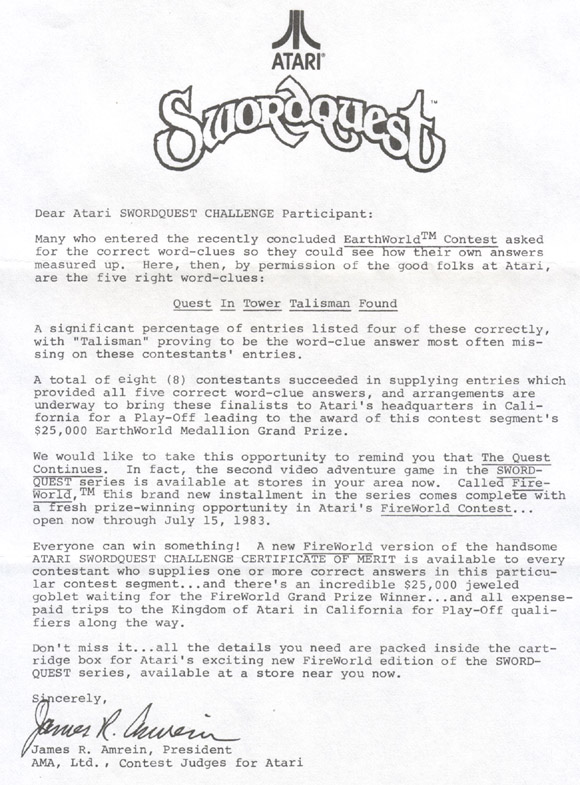
Certificate of Merit letters
|
EarthWorld prototype |
EarthWorld playoff contest prototype |
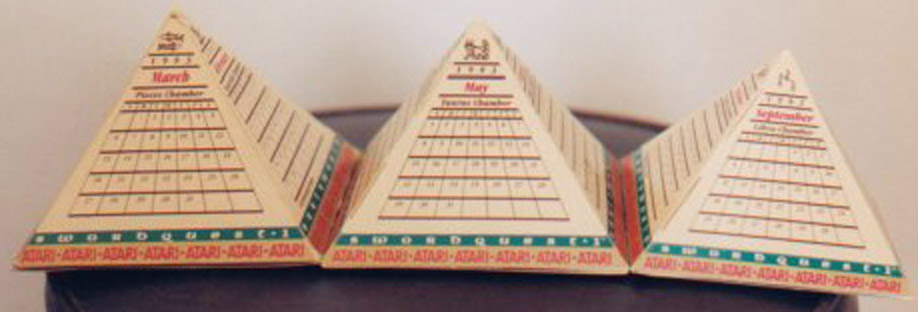
SwordQuest "pyramid" calendars. Photo courtesy of James Schweitzer.
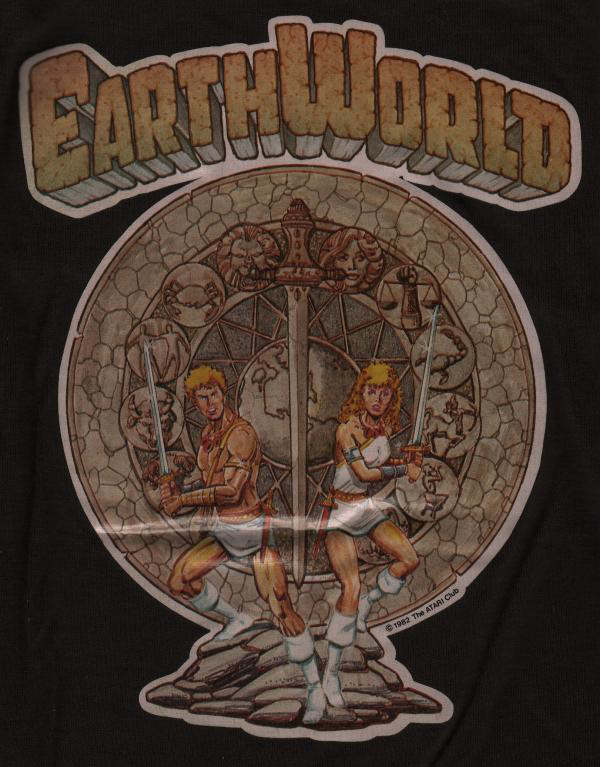
Rare EarthWorld T-shirt, only available through Atari Age. Artwork by George Pérez.

SwordQuest FireWorld
Programmed by Tod Frye
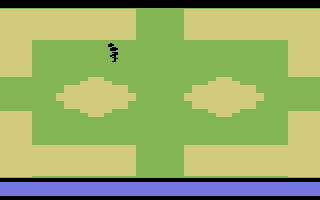
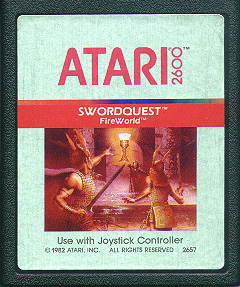
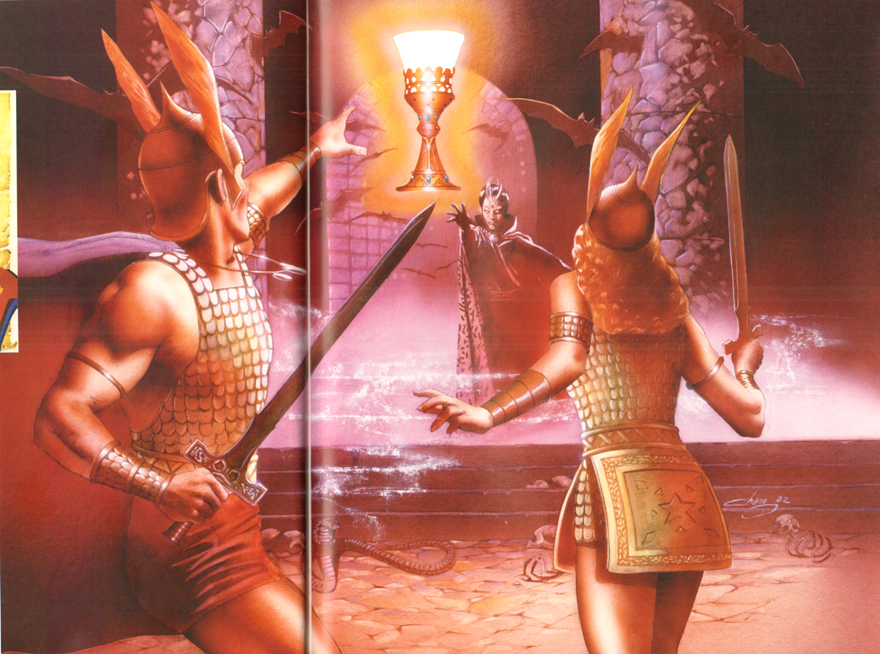
High-resolution image of cover art.
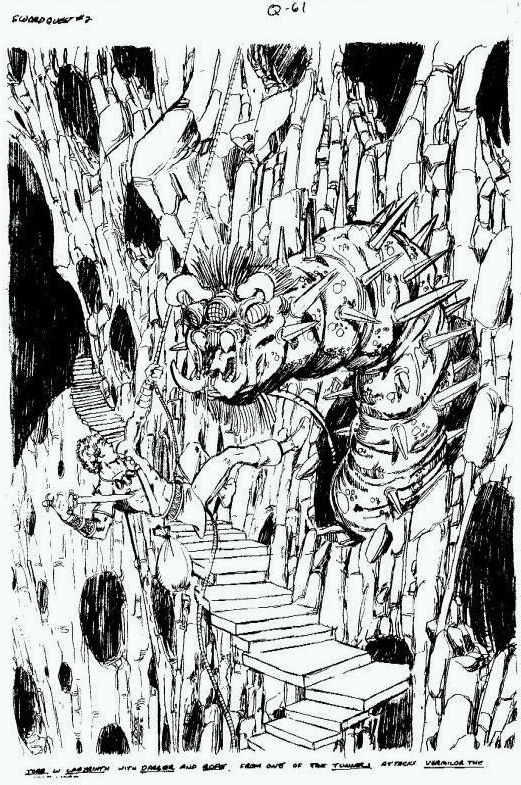
Early comic cover art by George Pérez. Click HERE for the complete comic, uninked!

Release info from the Jan/Feb 1983 N1N5 issue of Atari Age.
Gaming notes
† The game is based on the Tree of Life, which is found in the Jewish Kabbalah. The Kabbalah is based on 4 worlds, and has 10 "spheres" or "levels" called the Sephiroth. The 4 worlds are as follows:
Atziluth (Kether & Daath): The World of Origination
Briah (Chesed, Geburah & Tiphareth): The World of Creation
Yetzirah (Chokmah & Yesod): The World of Formation
Assiah (Binah, Netzach, Hod & Malkuth): The World of Expression
† It’s possible to “warp” up into adjacent rooms. In some rooms corner warping can be used to also go left, right, and down. Was this by design or a glitch? In room E, sometimes when trying to warp to room G you will reappear on the other side of the room instead. You can also get stuck on the walls in this room when trying to do corner warps.
† The doors in room E are affected by what items are placed inside. While the B doorway is always open, and holding the chalice opens all doors (including J), the following doors are opened with these objects:
F – Dagger
D – Warrior’s Sword
H – Amulet
G – Oil Lamp
C – Ring
I – Cloak of Invisibility
† Pictures of the FireWorld contest were found by Clive Young in 1999 and appeared in issue #58 of the 2600 Connection newsletter.
† The clues don’t have to be found in order. The meaning of the clue numbers is unknown, but it’s possible that being they were simply numbered from 00 to 09 meant that there were 10 word clues to find in the comic book.
† In the Jawing Salamanders skill test (room J), your “line” character gets longer each time you are hit.
† When you find a clue, occasionally a block (cursor) will appear in the inventory. To get rid of it, go in a treasure room and place your cursor over it and “drop” it, otherwise you won’t be able to carry 6 objects.
† Normally you have 8 chances to finish some skill tests (all but the Deadly Snakes and Fire-Breathing Dragons). Each time you fail, you’ll hear a “miss” sound. With the Goblins test though, you only get 7. Notice that when you first start the test you’ll hear a “miss”. There’s also a way to hear 9 “miss” sounds with the Flying Fire Goblins test– at power up, wait until you see the screen showing your character and then start the game. If the very first test you do is the Flying Fire Goblins, you’ll actually hear 2 “miss” sounds at the start, instead of 1.
† There are numerous glitches that appear with the skill tests. The screen will jump every time you transition to and from a skill test. With the Deadly Snakes test, you may be stuck on the screen when you start (your character won’t appear) or when you kill all of them (and the screen doesn’t change); with the Fire-Breathing Dragons, you may see a “bolt” of fire shooting up from the bottom when you start; with the Jawing Salamanders and Flaming Firebirds, the bottom border may disappear as you are hit. All tests seem to suffer from poor sprite-collision detection (ex. a goblin or knife may slip past you and not be counted as a miss).
† Luc Pycke programmed a Commodore 64 version of FireWorld, back in 1983! Unfortunately, programming was never completed.
PAL version notes
† As with the PAL EarthWorld, there was no comic book, poster, contest entry form, or contest sticker on the box.
† Did you know the PAL version of FireWorld has a different solution? The objects are also found in different locations. The solution below was also obtained by Luc Pycke.
† The PAL FireWorld box is also slightly different from the NTSC version – “SwordQuest ” appears in solid white lettering, with “FireWorld” in large letters underneath it.
† The inventory “block” glitch is more prevalent in this version. Clearing the block creates another rope item, which will appear in the room. You can actually create enough ropes to have 6 in your inventory and one in each room!
|
The Tree of Life glyph |
Room layout, using Russ Perry Jr.’s solution |
|
FireWorld NTSC solution
|
FireWorld PAL solution
|
|
FireWorld contest solution 1. Chalice, Amulet, Talisman, Warrior's Sword 3. Talisman 4. Rope, Grappling Hook 5. Oil Lamp, Food 6. Cloak of Invisibility, Shoes of Stealth 7. Dagger, Warrior's Sword, Short Sword 8. Amulet, Talisman, Ring, Water 10. Shield |
Contest notes
† There were 73 total finalists. To whittle down the number to 50, Atari had a “run-off” whereby they sent everyone a piece of paper with some questions, and the finalists had to write in so many words or less what they liked about the game. Out of those entries, the judges picked 50 contestants. Both EarthWorld winner Steven Bell and finalist Jacquie Custer were 2 of the 50 contestants. Charles Compton, Robert Ruiz Jr. and Russ Perry Jr. were also 3 of the 73 finalists. Russ Perry Jr. didn't make the cut to the last 50.
† At least 50 “championship” carts were made. Only one has been found to date, thanks to contest runner-up Rick Davidson. A photo of the cart (below) shows it to have a standard Loaner Cartridge label, and is dated 01-25-84. The code was also archived and shared. According to him, although the objects are all found in the same locations as the released cartridge, the solution is different. Here's his story on his contest experiences and how he obtained the cartridge:
| I'm afraid there is not lot I can
tell you that you have not already read in other interviews, except maybe
about the great buffets and dinners and tours that Atari treated us to.
I think those things would not be of much interest to anyone but the other
49 finalists and the few friends and family that were allowed to be with
us there. Most of their contact info and my copy of the clues and
other keepsakes and photos from the contest are buried in storage under 30
years of other stuff. But again, I would love to get those clues and
any contact info of the other players that I can. The cart I have is from the playoff. I don't want this to sound like 'sour grapes' or anything like that, because I really was quite satisfied with the outcome of the playoff and all the tours and banquets. At that time in my life, it was the trip of a lifetime. I never expected to win going into it. I think I ended up with the cart because my umpire felt sorry for me. I finished getting all of the onscreen numbers before Michael did, but my umpire told me I had one of them out of order and that I needed to go through them again in the right order. I told him that was no problem, because it looked like I had plenty of time to re-do them and still finish inside the time limit. I was about 5 minutes away from getting them in the right order when they announced Michael as the winner. On my way out, my umpire came up to me and said, 'Here. You should have won'. |
† The deadline for entering the contest was July 15, 1983. All the finalists were to be flown to Atari to compete in November of 1983, but the contest didn’t take place until January of 1984. The reason for the delay is unknown.
† The contest was held at the Holiday Inn San Francisco-Fishermans Wharf.
† The winner was Michael S. Rideout of Aiken, SC, who finished the game in 50 minutes.
† According to Michael Rideout, the only person he knew who found all 10 game clues in FireWorld was Charles Compton (the winner of Imagic's Riddle of the Sphinx contest).
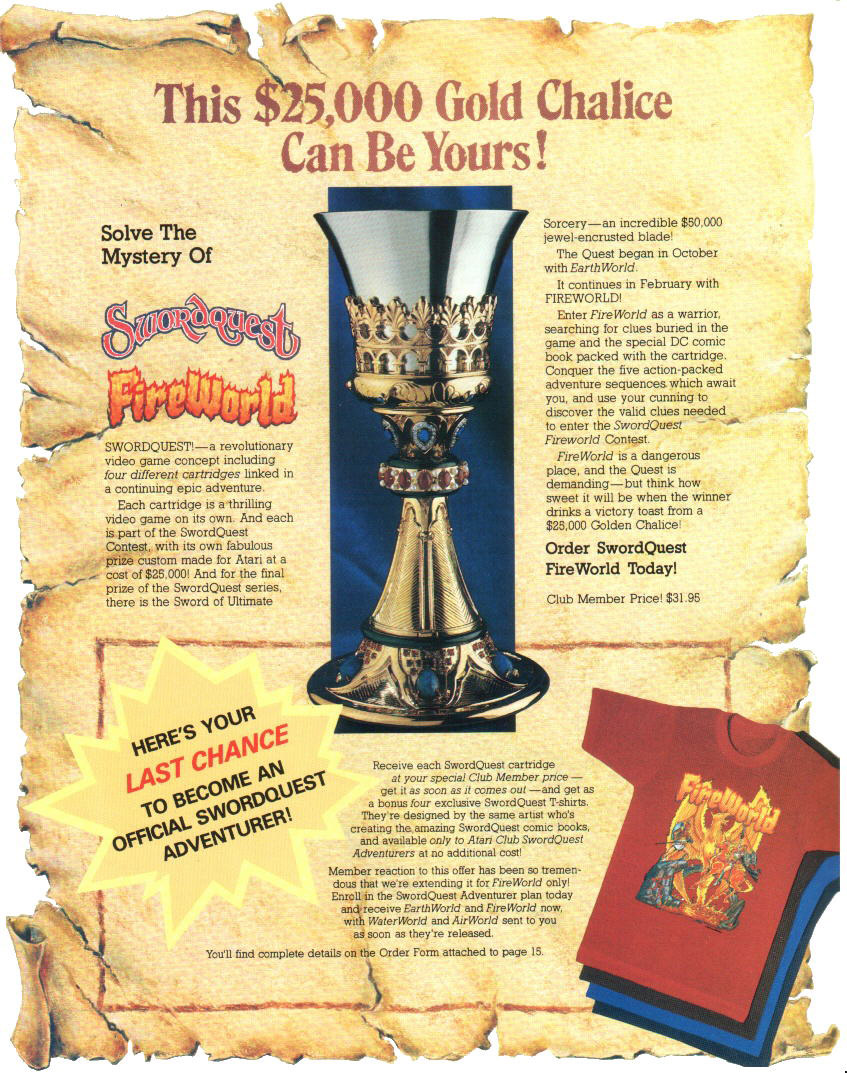
Atari Age ad, January/February 1983 V1N5 issue.
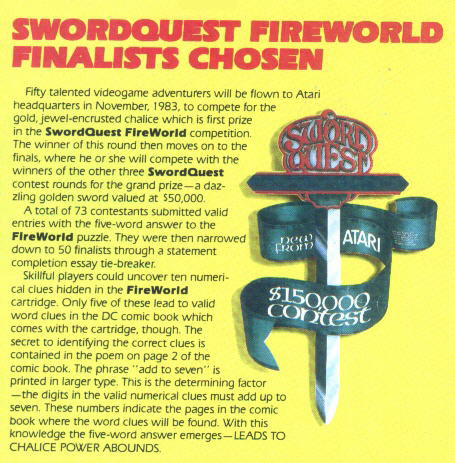
Atari Age FireWorld contest finalists article, September/October 1983 V2N3 issue.
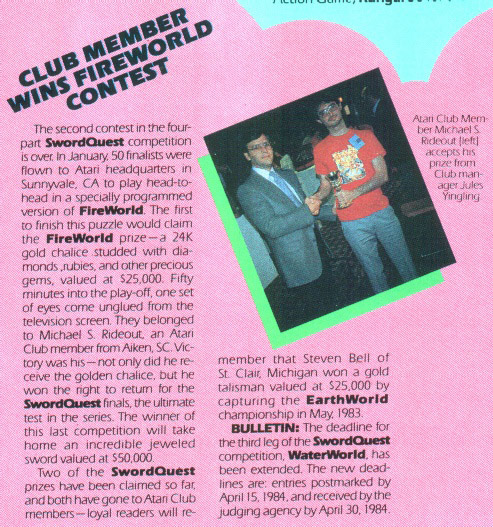
Atari Age FireWorld winner announcement article, March/April 1984 V2N5 issue.
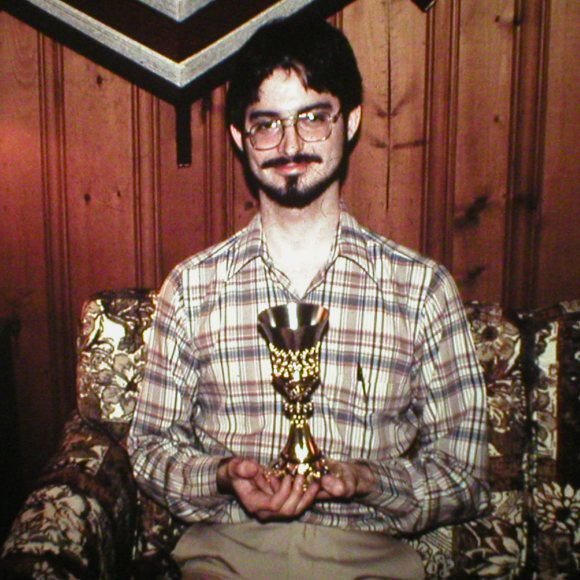
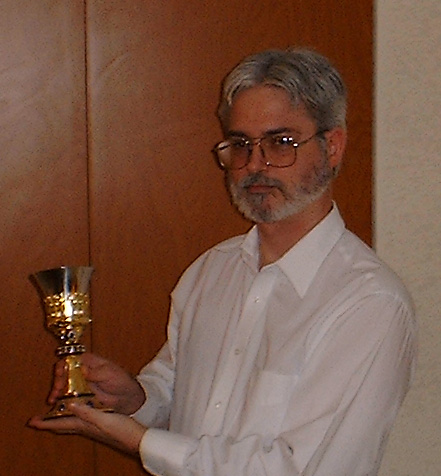
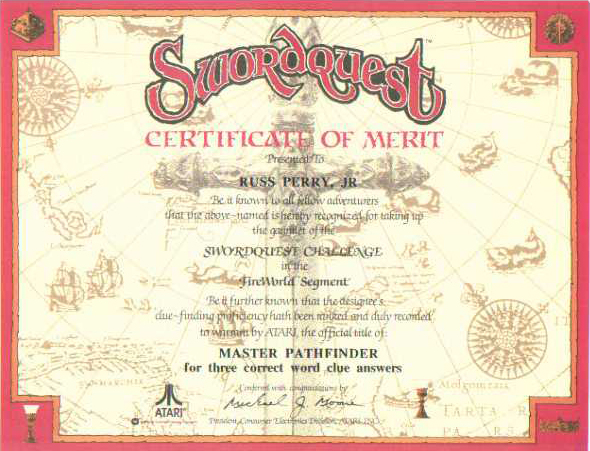
Certificate of Merit

PAL end label

FireWorld prototypes
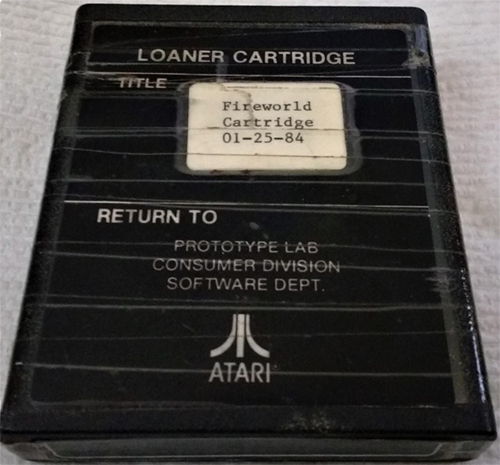
FireWorld contest cart
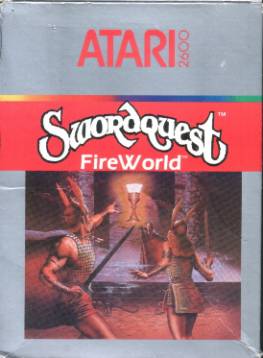 PAL box |
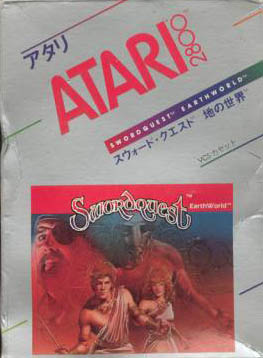 2800 “Japanese” box |
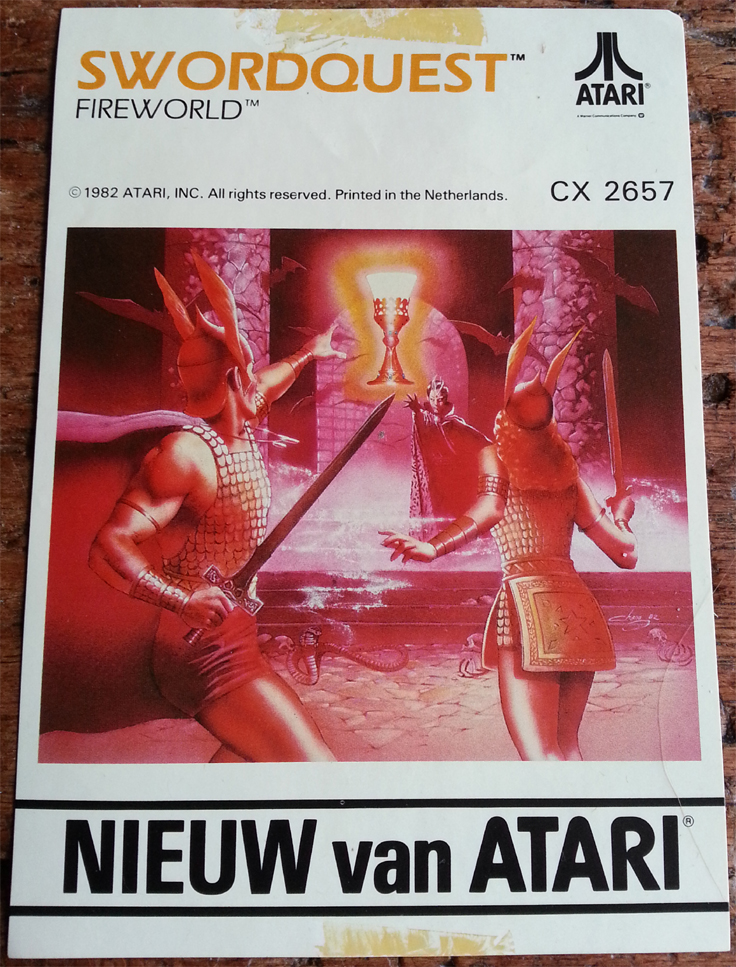
SwordQuest FireWorld flyer from the Netherlands.
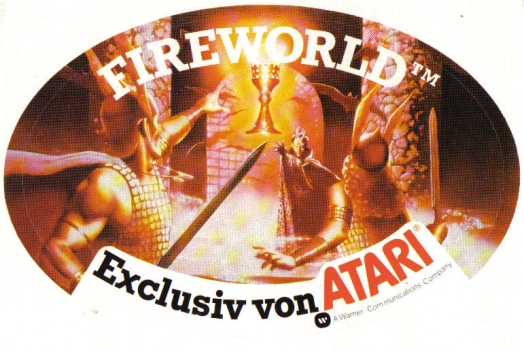
SwordQuest FireWorld sticker from the Netherlands.
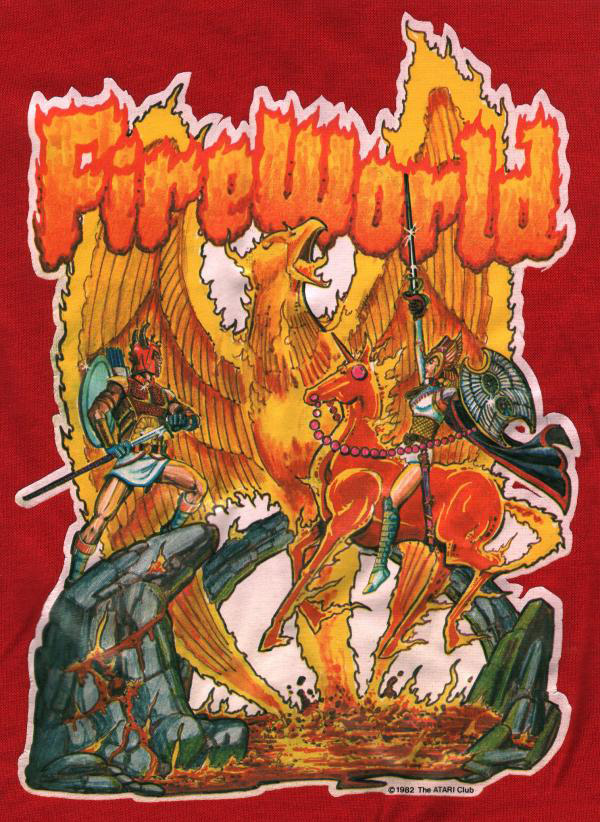
Rare FireWorld T-shirt, only available through Atari Age. Artwork by George Pérez.

![]()
SwordQuest WaterWorld
Programmer unknown
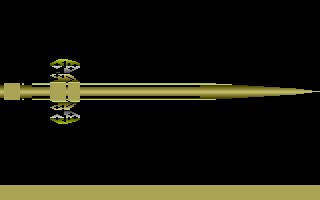
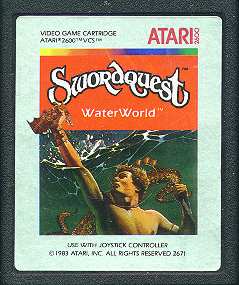
|
Packaging artwork by Warren Chang. |
Cover of SwordQuest WaterWorld comic. |
Cover of SwordQuest WaterWorld hint book. |
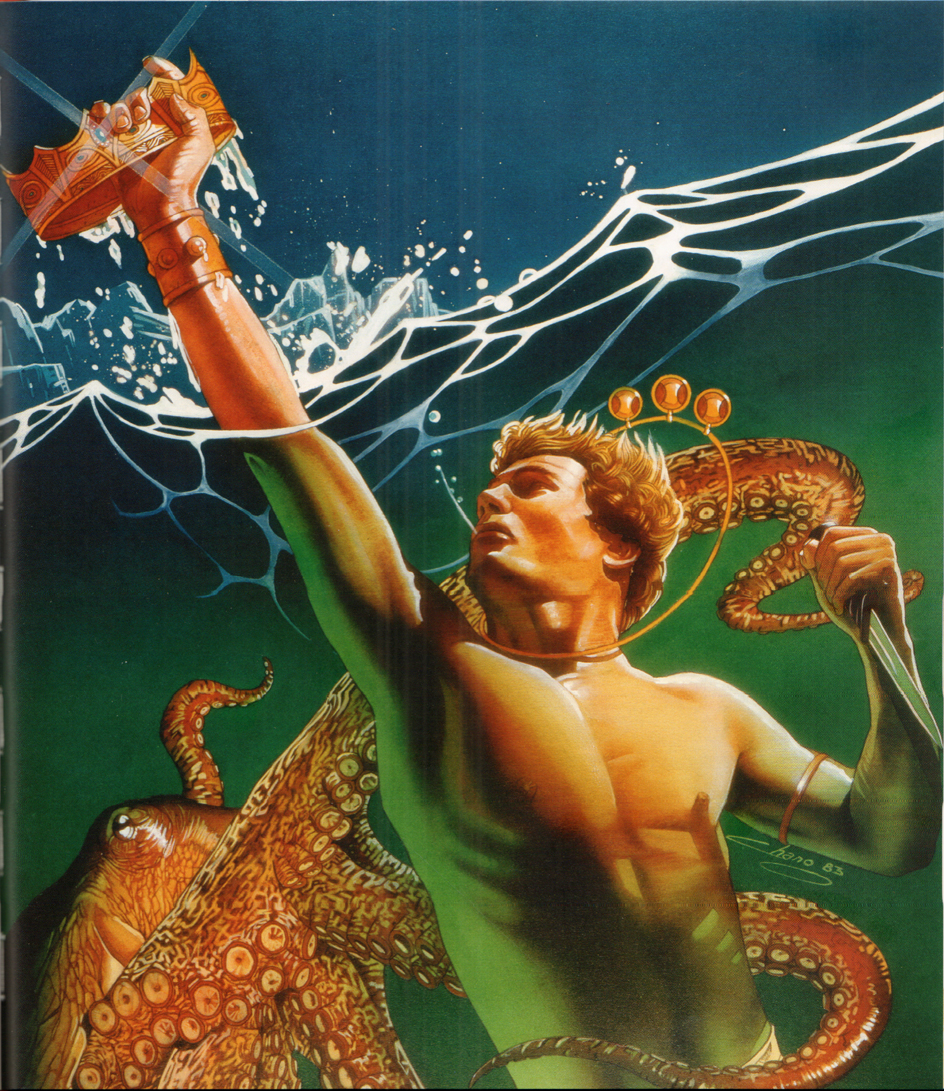
High-resolution image of cover art.
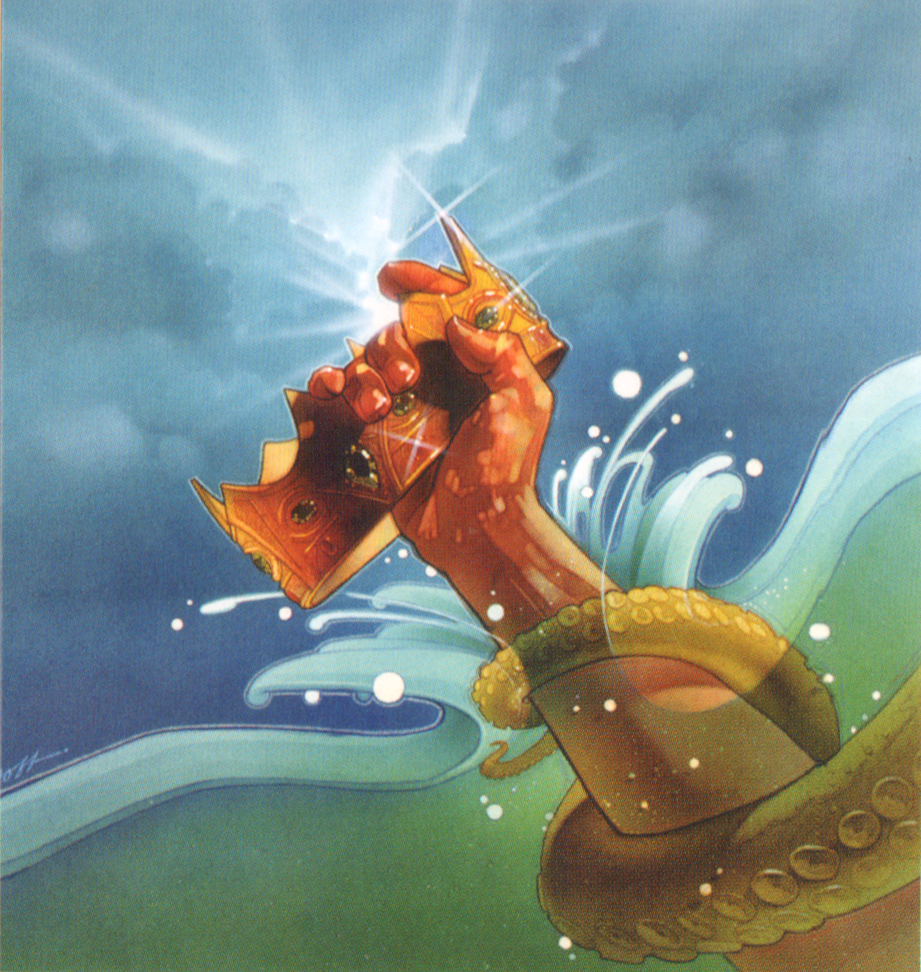
Rare promotional artwork by Terry Hoff.
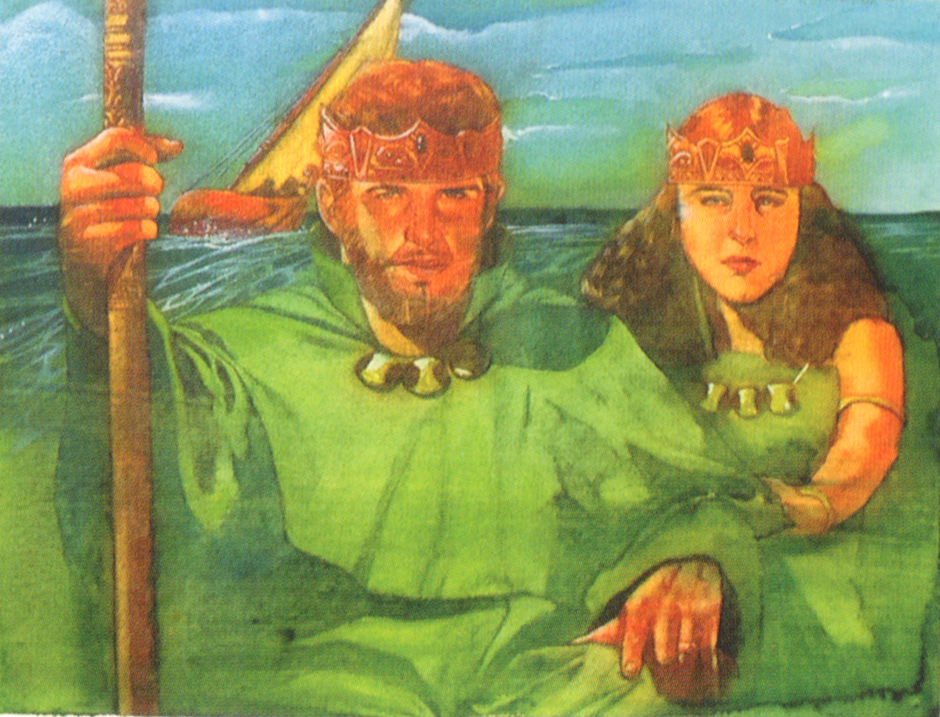
Concept artwork by Warren Chang.
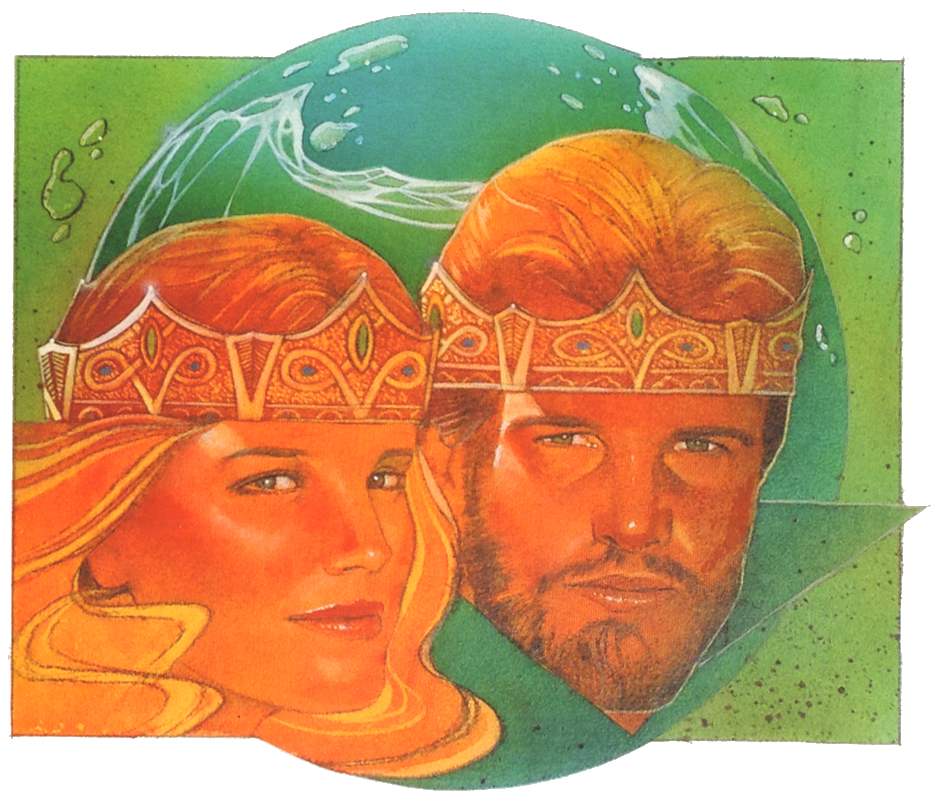
Concept artwork by Warren Chang.
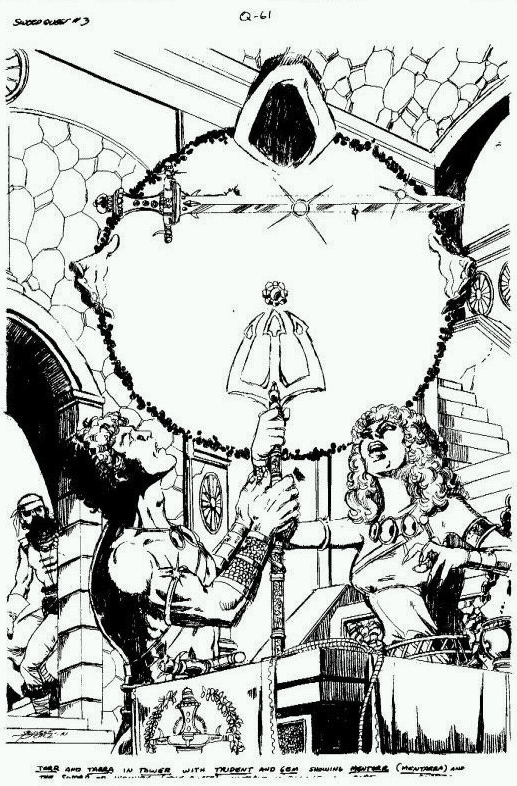
Early comic cover art by George Pérez
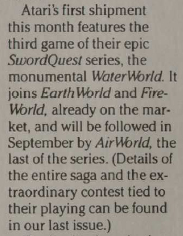
Videogaming Illustrated news blurb from the April 1983 issue.
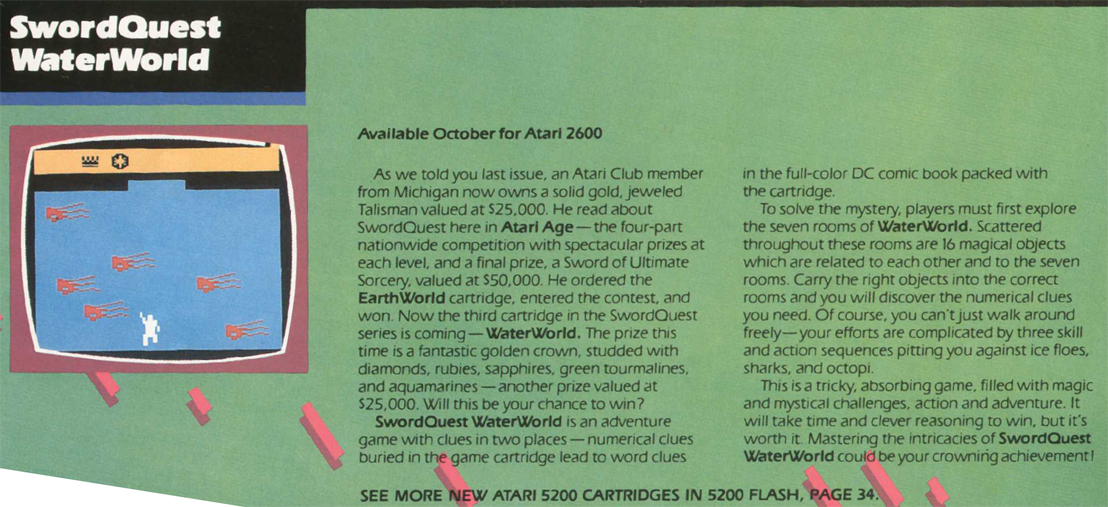
Release info from the Sept/Oct 1983 V2N3 issue of Atari Age.
Contest notes
† The game is based on the Kundalini Chakra. Go HERE to learn more about this, and to see a chart showing the 7 Chakras, and how it relates to the room layout.
† The game was supposed to be released by June 1983 but wasn't until October 1983, and then was only available through Atari Age.
† The original contest entry deadline was December 15, 1983, but was extended to April 15, 1984. WaterWorld was by far the easiest to solve and the only game to include a separate a hint book.
† According to a 1998 interview with FireWorld winner Michael Rideout:
| “They (Atari) chose the finalists although if I remember correctly, they reduced the number to 15 instead of 50. This caused a lot of people to get upset. This was right at the time Atari was sold and everything went into limbo. I don't think the Crown was ever awarded…”. |
† A PAL version was never released.
† Atari cancelled the contest before a winner was declared, although an ex-felon by the name of Curt Vendel believes Atari held a "non-public, semi-secret" playoff, but offered no proof to back up this claim, other than saying that, by law, Atari had to follow through with the WaterWorld contest because the game was publicly sold and players had submitted correct answers. Given Vendel's past felonious history, not to mention his track record of sabotaging shows, forging emails, and erasing posts, anything he stated as "fact" should be questioned.
If someone won a $25,000 crown, we would have heard about it before now, either from the person who won it or someone who knows them. We haven't. Also, the SwordQuest Challenge was a nationally-advertised contest. Vendel's claim that the WaterWorld contest had to be completed for the sole reason the game was released and people submitted entries for it doesn't ring true because the contest was comprised of FOUR games. Each game's contest was part of reaching the overall contest- to win the sword! Why else would Atari have paid off the winners of the EarthWorld and FireWorld contests if they legally didn't have to (because AirWorld was never released)?
From Michael Rideout:
| When Atari discontinued the contests, Steven and I each received compensatory checks for $15,000, and the 15(?) WaterWorld qualifiers each received compensatory checks for $2,000(?). I'm not positive about the number of WaterWorld qualifiers, but I believe it was 15 (see the next paragraph). I'm also not sure if the $2,000 figure is correct; it may have been $3,000 or even $5,000. All of my notes and documents related to Swordquest are stashed in a box somewhere, and it was over ten years ago, so my memory is a bit hazy. |
If Atari indeed had some "super secret" playoff, what of Rideout's claim of Atari paying off the WaterWorld finalists? If Atari paid off the 10 finalists at least $2,000 each, that would be nearly as much as what the Crown was valued at! But no WaterWorld finalists (or anyone else associated with the SwordQuest contest) have come forward to corroborate Vendel's version of events, and until someone does, this is just another unfounded rumor of his.
† The following are letters that Russ Perry Jr. received from Atari during the time of the WaterWorld contest:
(letter #1)
|
May 14, 1984 Dear Mr. Perry: As the independent judging agency for the ATARI SWORDQUEST CHALLENGE Program, we are delighted to inform you that your entry in the "WaterWorld" Contest has been officially graded and found to contain all four correct "word-clue" answers. In fact, your entry was one of the total 45 submissions received in this contest segment which supplied the four right words. Because the number of contestants who provided the four correct "word clues" exceeds 10 (as stipulated in the Official Rules ... please see photocopy attached), we are proceeding to the contest tie-breaker procedure described in Rule #5. This letter represents your personal invitation and only notification of participation eligibility in the WaterWorld tie-breaker contest. No other correspondence or telephone exchange may be entered into, and no responsibility can be assumed for lost, misdirected or late mail. Therefore, we direct your attention to the "statement-completion form" which accompanies this letter, calling for your own response to the starter-line "What I like about the Atari WaterWorld video adventure game is...". Your reply may be written long-hand or printed (clearly in ink) or typed on the form provided, and should not exceed in length the lined-spaces indicated on this one-sided sheet. Your statement-completion form should be sent via first class mail to the address indicated thereon and must be postmarked no later than June 15, 1984. All on-time tie-breaker entries will be held, unopened, until the first week of July when each shall be individually judged "on the basis of originality, sincerity and aptness of thought". The decisions of the judges shall be final. All entries become the property of Atari, Inc. and cannot be returned. Winner notification shall be effected no later than August 1, 1984; subsequent to such notification, personnel from Atari shall be in contact with the tie-breaker winners concerning timing and travel arrangements for the play-off trip to California.. leading to the WaterWorld Crown which is to be awarded as this contest segment's Grand Prize. Congratulations on having reached this advanced stage of the WaterWorld segment of the ATARI SWORDQUEST CHALLENGE! Sincerely, James R. Amrein, President Amrein Marketing Associates, Ltd., 45 Weston Road, Westport, CT 06880, USA (203) 226-2836 |
(letter #2)
|
August 7, 1985 Dear Mr. Perry: Atari was sold to new owners last summer and, with the attendant changes in personnel and future plans, we literally found ourselves at a point where there was such a program as the SWORDQUEST CONTEST. Not only did this situation take a while to correct, but then the lawyers had to resolve who was now responsible for the contest prizes (the new owners or the old owners). A very conscientious and industrious attorney for Atari has the matter in hand now and wants to resolve this matter in the very near future. I wish there was more we could tell you now, but our firm's role was simply to judge the entries. Prize payments are the sponsor's responsibility, and we found ourselves mid-stream in judging without a sponsor if you will. Thank you for your patience ... it's not been forgotten and is nearing resolution, and you'll hear from Atari on this sometime shortly. Sincerely, James R. Amrein, President Amrein Marketing Associates, Ltd. |
(letter #3)
|
May 30, 1986 Dear Mr. Perry: As you may know, Atari, Inc. sometime ago disposed of its computer and video game business, with the result that the SWORDQUEST promotion, originally conceived almost four years ago, no longer has value. A plan for resolution of the SWORDQUEST Contest has been reached with the firm which bought out Atari, Inc. Our agency served the original program as its independent judging agency, and we regret to inform you that your statement-completion entry in the "WaterWorld" tie-breaker was not one of the winning submissions. Thank you for your patience and your participation. Sincerely, James R. Amrein, President Amrein Marketing Associates, Ltd. |
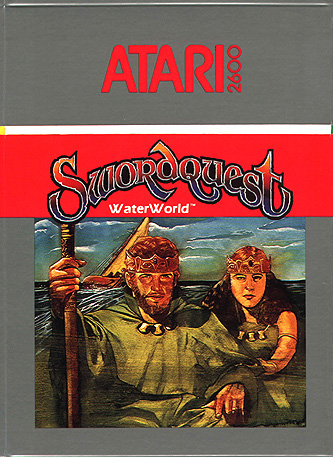
Prototype box/artwork
.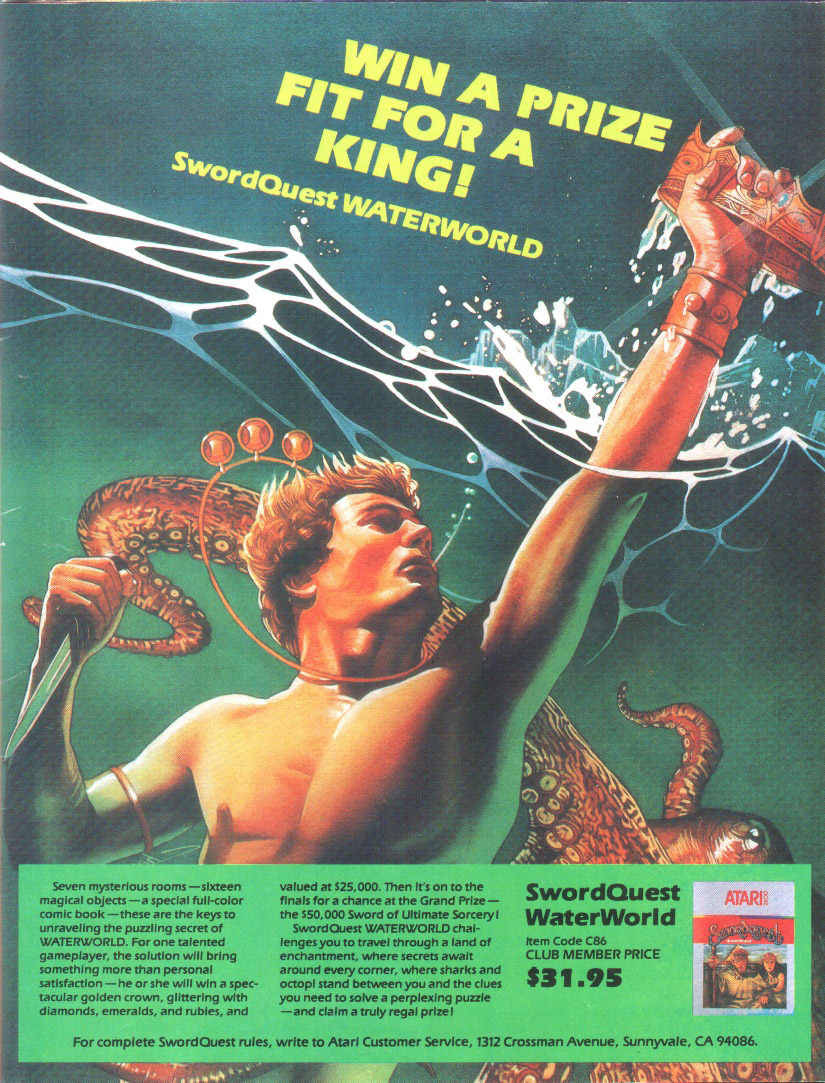
Atari Age ad, from the Sept/Oct 1983 V2N3 issue. Note the background art is mirrored, and the box shown has earlier artwork!
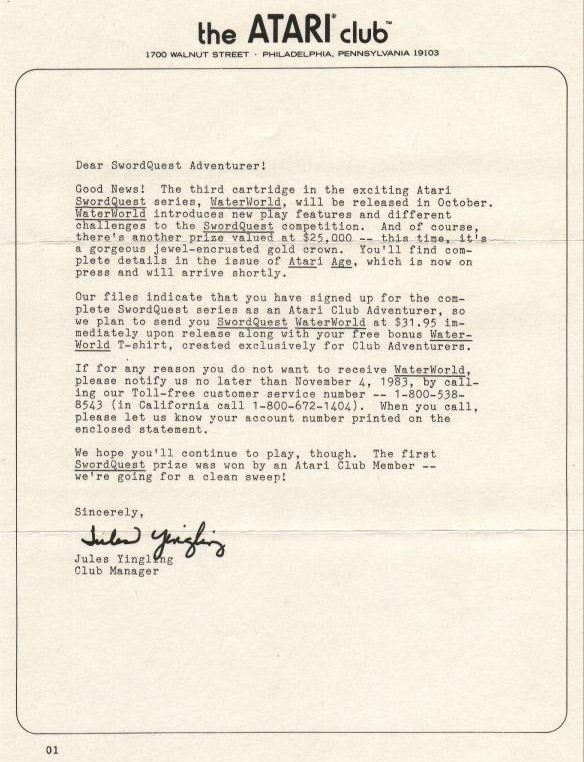
Atari Age Club letter for upcoming WaterWorld release.
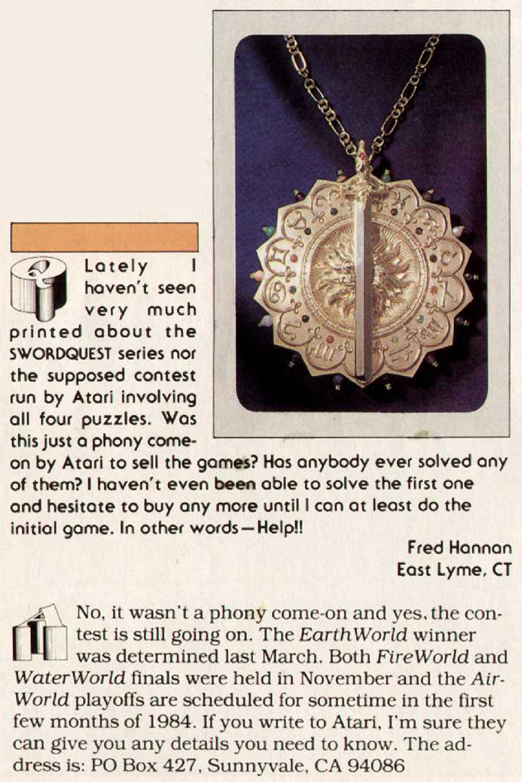
Electronic Fun letter, January 1984
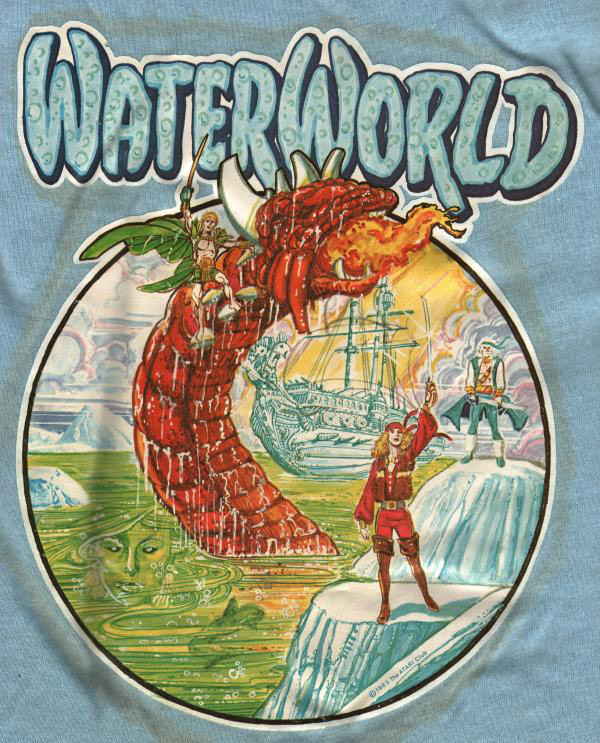
Rare WaterWorld T-shirt, only available through Atari Age. Artwork by George Pérez.

![]()
SwordQuest AirWorld
Programmed by Tod Frye
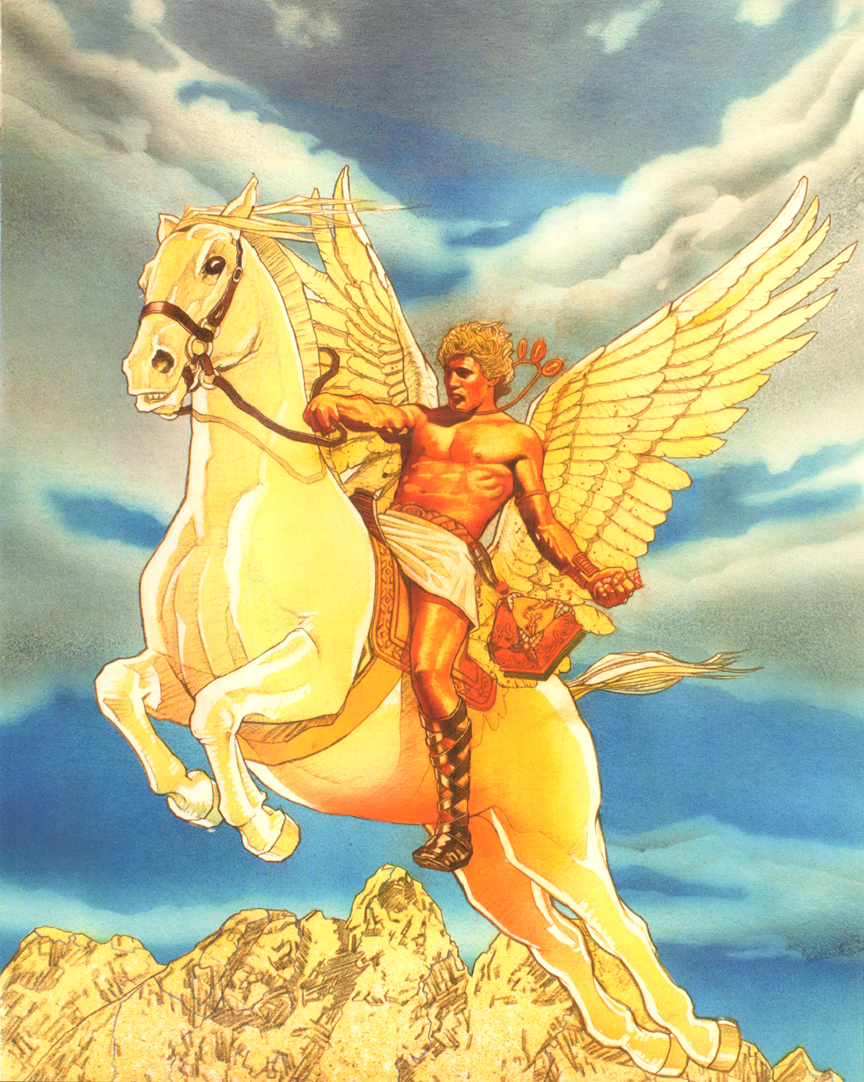
Rare artwork by Warren Chang for AirWorld. Note the Philosopher’s Stone just under the rider’s left arm
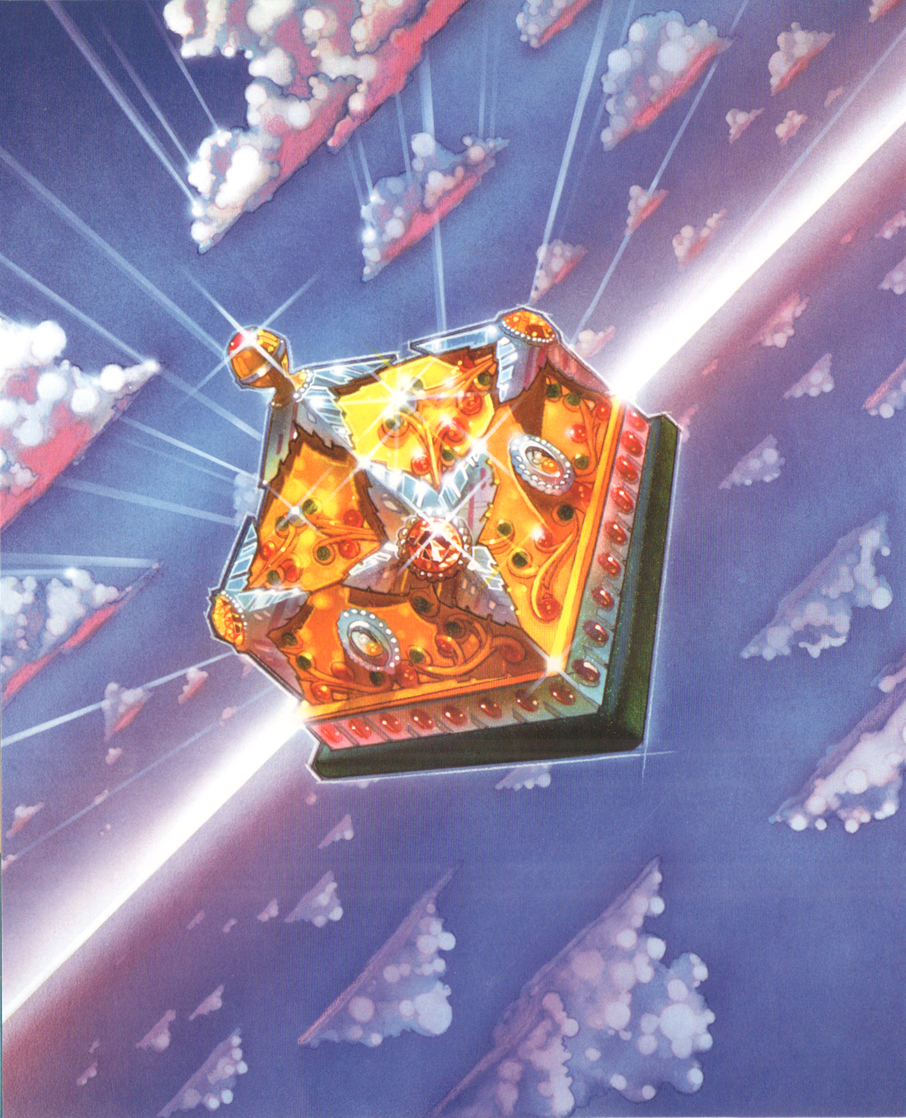
Rare promotional artwork by Terry Hoff for the Philosopher’s Stone.
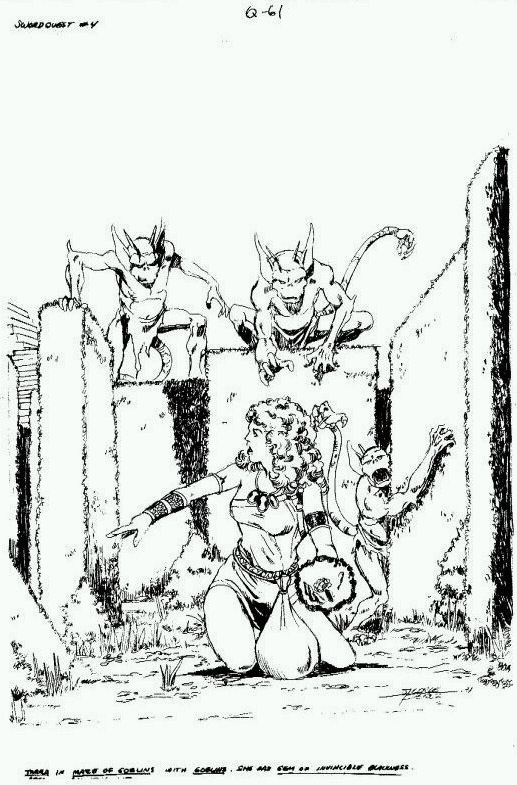
Early comic cover art by George Pérez.
Gaming notes
† The game is based on the Chinese I Ching (the “Book of Changes” - go HERE for more information). It consists of “tribars” – sets of 3 bars that can be either whole or split – and there are 64 different tribar combinations, called hexagrams. The gameplay in AirWorld was based on a 64-bit game language that determined the player’s speed, enemy A.I., and other factors.
† The above artwork supposedly came from Brian Ballestri, who was an editor for the internal Atari company newsletter, Atari Life.
† A copy of Atari's internal product assembly list for AirWorld can be found HERE.
† According to Tod Frye, he was only about 20% done with the game, but was pulled off the project to do the 2600 version of Xevious. Soon after, the entire SwordQuest project was cancelled. Here are some of his comments:
From a letter in the March/April 1997 issue of the 2600 Connection newsletter regarding a fake AirWorld game, Russ Perry Jr. mentioned he talked with Tod Frye, who stated the AirWorld kernel was only 20% complete when he was pulled off the project to do Xevious.
(dated 8/02):
|
AirWorld did get started, and I was digging it, but I got asked to port Xevious to the 2600 after 2 other programmers gave up on it. AirWorld prototypes never reached the playable stage. In the game, there was a screen where one flies about, and then centers on a hexagram on the horizon. One then flies into the hexagram, which zooms to fill the screen, and then plays one of 64 scenarios - one per hexagram. I would be really surprised if it were even possible to find the code for the initial AirWorld prototypes. AirWorld was based on the I Ching. As far as I got, it was never fully playable. But I was psyched to be doing it. One flew around in a (sort of) first-person flying scenario with 64 hexagrams on the horizon, dodging some stuff in the air, and picking some other stuff. When you picked up a certain token, you entered the 'in hexagram' phase, where you locked on a hexagram of your choice on the horizon, and it zoomed up to fill the screen, where you played one of 64 simple games (the 64 simple games never got finished, too ambitious). |
In 2018 Tod was interviewed by Arcade Attack and had this to say:
| What I intended for AirWorld was a, if at all possible, a game with emergent gameplay where there were these 6 lines in a hexagram which is composed of 2 trigrams of 3 each and it's all part of this very sophisticated and ancient mythological system from China. And I intended to put together a game and start it. I had my hexagram on the screen. There's a lot more to it then that. And I was spending my time looking at the I Ching and trying to come up with a way where I could derive the rules for gameplay from the hexagram, and have each of the 64 gameplay screens be unique and related to the yin and yang lines in the hexagram, and if at all possible related somehow to the mythological meaning of the hexagram and the I Ching itself. It was really ambitious. In some ways it would be like, if you start this stuff thinking, here I have hexagrams with yin and yang lines. How about if I do a thing where, look at Taz, which was done by Steve Woita, which is a very row-based game, where you have bunches of rows were objects are moving horizontally and you have the player which can jump between the rows. So I was going there, and I was going, so what if I do a thing where your object on a yin line is one you want to pick up, and an object on a yang line is one you want to avoid. And then, find some other set of rules which they use to decide whether they want to track you or dodge you, whether they go fast or slow, whether they bounce at the edges of the screen or whether they wrap around the edges of the screen. I was trying to work out a logical grid of generated gameplay, and it was a lot of thinking. It was actually very ambitious. |
† According to former Atari programmer John Seghers, he remembers seeing Tod Frye testing out AirWorld, and confirms the room structure (layout) was based off of the I Ching (possibly 8 rooms, each representing a different tribar?). The game screen he saw was a first-person flying perspective of your character flying over a landscape – he believes it was suppose to be Torr on the flying horse (as depicted in the above artwork). Howard Scott Warshaw also confirmed the I Ching was the basis for the game during his presentation at the 1997 Electronicon show.
† The final comic book in the series was rumored to have been at least written and story-boarded – possibly even completed, or very close to it. There was once talk of DC completing the book series and releasing it as a graphic novel, but this never came to pass. Whatever artwork still exists is currently “lost” within DC Comics’ vaults. I asked DC artist George Pérez about this HERE:
| No, there was no "AirWorld" story ever written or drawn. The whole SwordQuest project was terminated by Atari before we could even start on the art. Roy Thomas and Gerry Conway, the original writers of the comics, may have worked out some sort of plot synopsis dealing in the generalities of that final chapter for Atari approval, but it never got to plot form. |
† Was a T-shirt designed for AirWorld? The Atari Age articles from the Sept/Oct 1982 V1N3 and Jan/Feb 1983 N1N5 issues suggests all the shirts were done at that point, although only the artwork for EarthWorld and FireWorld were shown.

![]()
Final notes
† An article in the January 1996 issue of Ultimate Gamer featured a meeting with John Skruch, Atari's Director of Software Development, and he had this to say about the contest:
| After the Tramiel takeover, many of the company's loose ends were simply left hanging. The ongoing SwordQuest contest was immediately deemed to be the responsibility of "Old Atari". Only the first two games in the series (EarthWorld and FireWorld) had been published - and the contest prizes related to those titles had been awarded at the time of the takeover - so, as a gesture of good will to its customers, "New Atari" closed the door on the SwordQuest promotion by sponsoring an event in which players competed for less valuable prizes by playing prototype copies of WaterWorld. |
Skruch also hinted that Atari never even started to develop the fourth and final game in the series, SwordQuest AirWorld. Needless to say, Skruch's comments about this final SwordQuest event were bunk, as were his comments about AirWorld's development not even starting.
† An excerpt from an interview with Michael Rideout states:
| When I was in the FireWorld contest, there was a group of people that had been in EarthWorld, that said to me "Now, if Atari ever comes to you, make sure you don't agree to anything about canceling the contest." I guess they had a suspicion that Atari might try to do that. After a while, I got a letter from Atari stating that they wanted to cancel the contest. They offered Steven and myself $15,000 each to agree and they offered a smaller amount, maybe like $2,000 to each of the finalists for WaterWorld. I think the reason Steven and I got more than everyone else was because as winners of the first two contests, we had a definite chance of winning the Sword. Everyone involved had to agree or else the contest would continue. I tried to call Steven and some of the other people from the contest to see what they were going to do but I couldn't get in touch with anyone. I talked it over with my father and decided to accept the offer, figuring that someone else would decline. |
† In 7/09 I asked James R. Amrein what he recalled about the contest. His comments:
| An Atari attorney named Angelo Pisani stepped up to take responsibility for attending to prize awards due contestants, and that was the last we knew of the Swordquest matter, our firm's judging responsibilities having been fulfilled. If you can find Angelo, you may very well be on to the final chapter in this. Other client-side names that date back to that time in Sunnyvale included Marketing Director Jewel Savadelis, a fellow in Marketing with some involvement in Swordquest named Steve Bengston, and a Marketing Dept. promotion type name Ralph Giuffre ... Ralph moved on to Activision and later an area of Disney in Burbank and then I lost him. I believe he's an alum of Santa Clara so it's conceivable its Alumni Relations area would have current contact info for him. |
† One of the SwordQuest FireWorld contest finalists was Robert Ruiz Jr. He wrote a letter that was published in the April 1985 issue of
Electronic Games, urging people to contact Atari and pressure them to complete the contest. As it turns out, he was the person who sued Atari when they cancelled the contest. Another letter of his appeared in the May 1984 issue of
Computer Fun, offering copies of the EarthWorld solution (his phone # and address were listed, but the # is no longer valid). Robert Ruiz Jr. thanked Steve Doussa, Jackie Custer, Steve Bell, Tom Neill, and Matt Balasa (all of them EarthWorld finalists) for helping him put his EarthWorld package together.
Not everyone who ordered his solution received it (most notably, Russ Perry Jr.). One of those who did,
Anthony Sandridge, was kind enough to send copies. It includes 6 pages of maps and notes for solving EarthWorld, and a
2-page letter dated 7-7-84 and signed by Ruiz. Consequently, Anthony also mentioned that Ruiz also offered solutions for FireWorld and WaterWorld, which he ordered as well, but never received them. Another person who wrote Ruiz was
Dan Amrich, who received not only the same 2-page letter, but
7 pages of maps and notes for solving FireWorld, as well as another 2-page hand-written letter (dated
9-27-84) on his "Adventurer's Club" letterhead, where he mentions the future plans for his club:
● The Progression
● Tips on different video and computer games
● Solutions
● The "Gamer's Choice" Contest
● Phase II: the Club's official magazine
As far as we know, none of his future plans ever materialized.

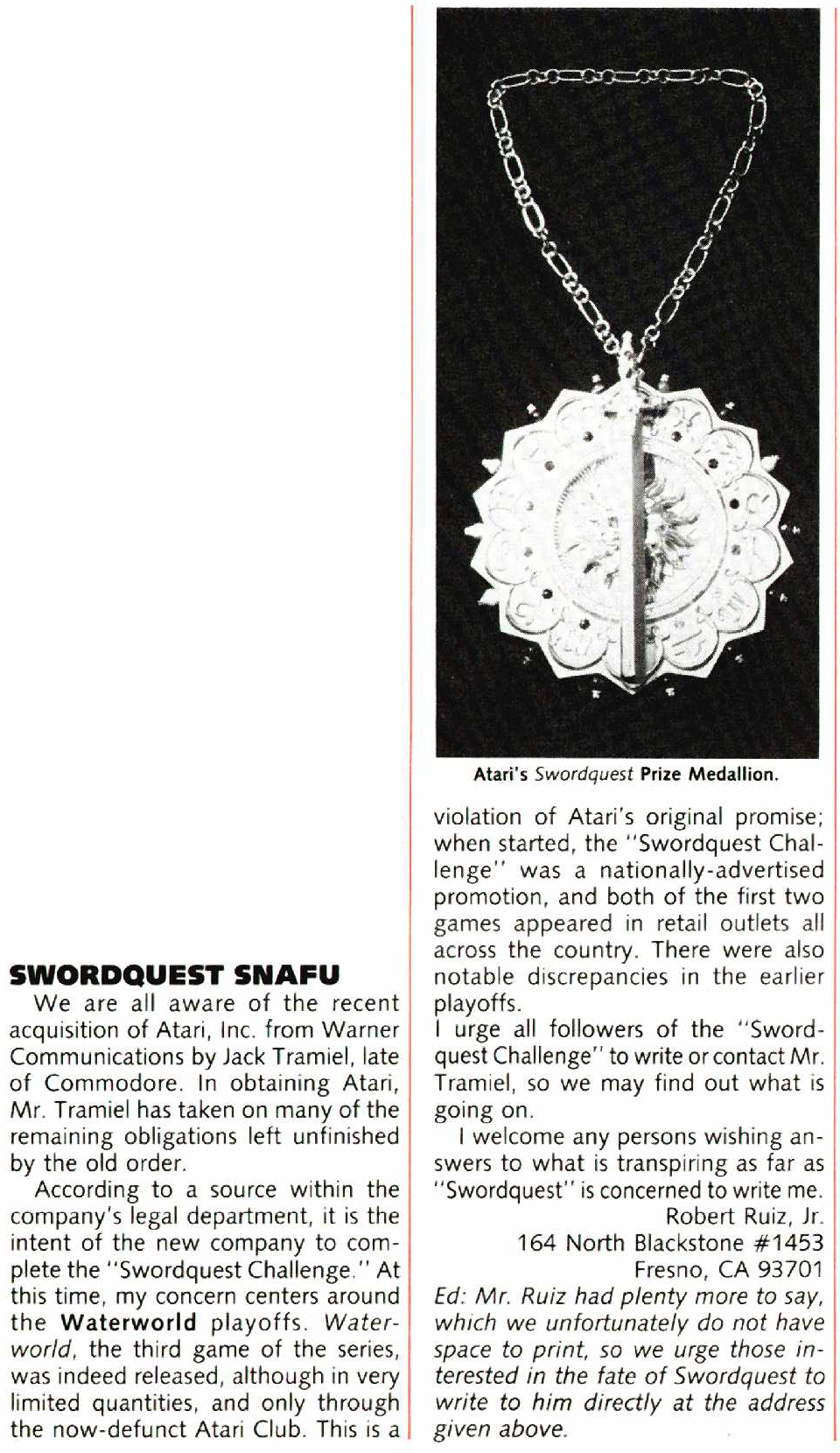
(LEFT) Computer Fun 5/84 letter; (RIGHT) Electronic Games 4/85 letter
† To date, no one is sure who actually solved the NTSC versions of EarthWorld and FireWorld. Was it done by Robert Ruiz Jr. and 5 other players through brute force trial-and-error? Or was the solution “leaked” out by either the programmers or an associate (as was done for the PAL versions). There was never a formal announcement from Atari. If anyone has any information concerning this, please email me.
† Fake Atari historian and ex-felon Curt Vendel once claimed in the March/April 1997 issue of the 2600 Connection newsletter that he found a prototype copy of AirWorld. He said it came in a shopping bag full of VCS ROM chips and prototype boards. One chip was labeled AirWorld and according to him, it was a "strange looking chip. It's not even an EPROM. It's something odd." He compared the game to the other 3 SwordQuest games and said it appeared "different", and then went on to describe Fireworld ("Most of the challenges involve going against birds and flying knives, and each room has what appears to be cloud looking objects."). He then took it to renowned Atari experts like Leonard Herman and John Hardie, who immediately recognized it as nothing more than a FireWorld ROM chip.
† Jeremy Jones attempted to sell off a fake AirWorld prototype several times over a 3 year period. The May/June 2000 issue of 2600 Connection stated that Jones had listed it on Ebay and then removed it 2 days later. He later posted it on the Atari Nexus site, trying to sell it on there, without success. In April 2002, he posted on Atariage under the alias "R Dvorjak", claiming there were 2 prototypes that originally existed. Ken Van Mersbergen (AKA "Dutchman2000") contacted Jones, at which point he claimed to actually be Tod Frye! A few months later, in August 2002, he again tried to sell his fake cartridge, and posted on Atariage under the alias "Flexured". Here are the fake screenshots he created, along with the fake cart:
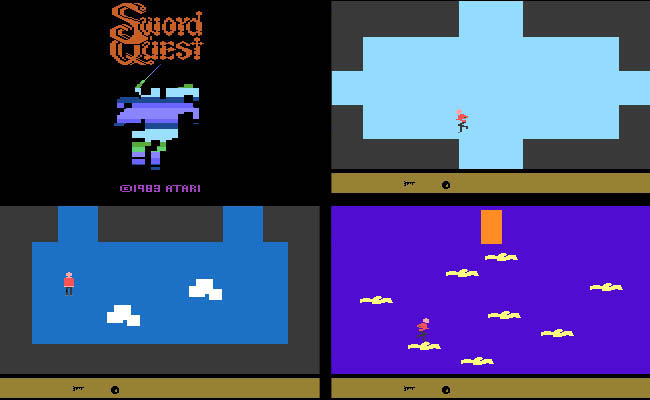
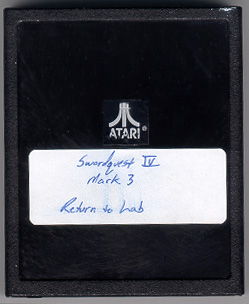
Below are 2 replies from Tod Frye, who helped to prove these pictures were fake:
(reply 1)
| All bogus. AirWorld was started, but never completed. The screens shown on his (Jones’) website are variants of the FireWorld concepts. This website is completely bunk. So sayeth me, who knows. |
(reply 2)
|
That AirWorld cart I saw? Screenshots look like EarthWorld, with some modifications to the graphics data. This would not be all that hard for a moderately competent 'hacker' to do. Just find the data tables in ROM, and patch them. So, what the heck. Those screen shots were almost definitely from a modified EarthWorld. |
The truth is, the fake screenshots were not from a hacked ROM but rather a Photoshop creation using a combination of EarthWorld screenshots, original artwork, and even a character from a different game (the horse on the title screen is actually the Nazgul from Parker Brothers' Lord of the Rings game). Also, the inventory objects are too detailed for the system’s hardware, and (on close inspection) the player’s character reveals a green background pixel from the original EarthWorld screen the character was taken from.
† Everyone knows both the games and the contest failed to deliver on what was promised. The games were not fun to play and - with the exception of WaterWorld - proved too hard to solve within the timeframe of the contest. The comic books were really all one needed to obtain the correct clues and enter the contest. Atari also failed to release all the games within the 1-year timeframe they originally stated - between Fall 1982 and Fall 1983 as stated on the EarthWorld contest entry form. Although EarthWorld and FireWorld were released within 6 months of each other (October 1982 and February 1983 respectively), WaterWorld wasn't available until October 1983 (it was supposed to be released in June), and only as an Atari Age exclusive. The contest playoff for WaterWorld was also delayed, most likely because the game was much easier to solve and more people entered the contest. By the time Warner sold Atari (in July 1984) the WaterWorld contest still hadn't been held and AirWorld was far from being finished. Later that same year, copies of WaterWorld were available in discount bins for only a few dollars.
† Perhaps some homebrew programmer(s) will take up the challenge of fixing the games (particularly EarthWorld and FireWorld), making them more playable and the solutions more logical. The games could have been connected to the comics more accurately, perhaps by putting objects in rooms as shown in the comics. More action sequences could be added, such as one for every room. Lastly, some sort of ending screen could be created for completing the games.
† The Angry Video Game Nerd, James D. Rolfe, devoted an episode to the SwordQuest contest, featuring some of the photos from this article:
† As a side note, a computer software company called ScreenPlay developed a series of 4 games. Called The Warrior of RAS and released in 1982, the company claimed skills learned in one game would be useful in the next. It's unknown when exactly these were released, but it's certainly a possibility ScreenPlay was trying to cash in on all the press for Atari's SwordQuest series, as the magazine ad for it prominently featured a sword:
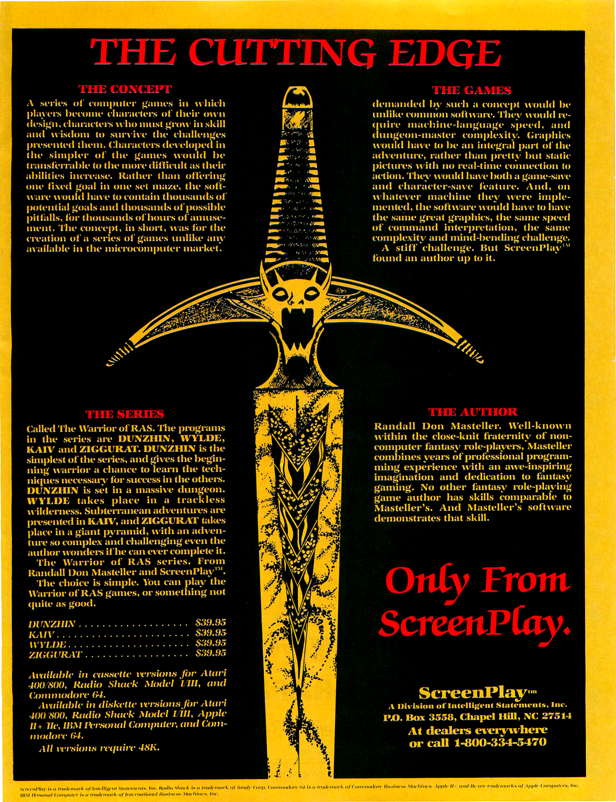
† In 2022 Atari released Atari 50: The Anniversary Celebration for the XBOX, PS4, PS5, and Switch. This is a compilation of 104 games for all of Atari's home gaming systems: VCS/2600, 800, 5200, 7800, Lynx, and Jaguar, as well as some arcade games. There's also 6 new games from Digital Eclipse, one being SwordQuest AirWorld. Below is a complete longplay video of the game. As expected, this is nothing like the game Tod Frye was developing and instead looks similar to the other 3 SwordQuest games.
† In 2024 The Legend of SwordQuest podcast debuted. Written by Jake Rossen and hosted by Jamie Loftus, it featured new interviews with EarthWorld winner Stephen Bell and Warner Executive VP Manny Gerard. None of Jack Tramiel's 3 sons - Leonard, Sam, and Gary - agreed to be interviewed for this, which would have helped confirm/deny the remaining prizes were in the Tramiel family. In part 8 of the podcast, it's mentioned 2 of Sam's kids, Mark and Gabriel, co-managed a franchise coffee house in Toronto, Canada called Aroma Expresso Bar until 2013. In 2011, a worker at Aroma, Casey Jones, asked Gabriel about the SwordQuest prizes, and according to Jones, Gabriel not only saw the prizes at Jack's house, he even had a picture of himself with 2 of the prizes, and Jones had a sense that the photo was taken within the last few years. Mark Tramiel possibly confirmed this with Jones, but he hasn't responded to recent inquires about it. Mark is currently a realtor for Re/Max Gold (LINK). Gabriel died in 2016 of a drug overdose. It's unknown if anyone reached out to Gabriel's wife to ask her.
Stephen Bell stated in the 4th part of The Legend of SwordQuest podcast, Descent Into Darkness, he got a letter from Atari in October 1986 with a settlement offer of $15,000 to cancel the contest - the same offer Michael Rideout mentioned in his 1998 interview. Rideout also confirmed the terms of the offer, that everyone had to agree or the contest would continue.
† To date, it's unknown for sure what happened with the remaining 3 prizes. It has long been rumored that the SwordQuest Sword (and possibly the other prizes) ended up in the hands of Jack Tramiel, and the 2nd-hand information from The Legend of SwordQuest podcast would seem to give some weight to that theory. The earliest public statement about this was when Clay Halliwell posted this in his Jaguar Explorer Online newsletter, issue October 15th, 1997 (V1I3):
| "Useless Fact O' The Month: Remember the $50,000 grand prize sword for the SwordQuest contest Atari was running? Well that sword is hanging over the mantle of Jack Tramiel's fireplace." |
There was no source mentioned for this information, but the likely person responsible was ex-felon Curt Vendel, who first claimed credit for it in the Jan/Feb 1998 (#45) issue of the 2600 Connection newsletter:
| "Curt at www.atari.nu stated he knows an ex-Atari programmer that worked on Unix for the TT030s who is personal friends with Jack. This person has been to Jack's home on many occasions and has described a large, solid gold sword with a FUJI symbol on it." |
On April 13th, 1998, Vendel made this RGVC newsgroup post:
| "I found out several months ago from a close friend of Jack Tramiel the former owner of Atari, that the $50,000 sword of ultimate power is hanging over his fireplace in his home in California." |
The only artwork to depict the sword having the Atari logo on it was on both the Challenge EarthWorld poster/contest entry form and the EarthWorld pamphlet. All the other artwork is identical to the only known photographs of the sword (from both the Observer-Reporter newspaper and the FireWorld contest). It's possible the Atari symbol is only on one side of the handle, though highly unlikely; why would the Franklin Mint mark valuable prizes with a company name or logo? Years later, both Vendel and one of his 'yes' men, Martin Goldberg, refuted the 'myth' of Jack Tramiel having the sword (without acknowledging that Vendel was the source of that myth) and claimed to have spoken with either Jack Tramiel or his son, Leonard, with both claiming Jack did not have the sword or the other 2 prizes, in several public statements between 2010 and 2014 (LINK 1, LINK 2, LINK 3). In 2014, both Vendel and Goldberg claimed the prizes were returned to the Franklin Mint and that Atari never retained them, and even claimed Manny Gerard confirmed all this with them. As was often the case with Vendel and Goldberg, neither offered any evidence or proof to back up their claims, and when Gerard was interviewed for 2024 The Legend of SwordQuest podcast, he had zero recollections of what happened with the prizes. It's worth noting that Warner Communications sold Atari to Jack Tramiel in 1984, thus ending any connection with either Warner Communications or Manny Gerard. What's more, the podcast questioned Ken Van Mersbergen's original comment ("We talked to the Tramiels - Leonard, Sam, and even Jack himself") claiming the sword above Jack Tramiel's fireplace was not the SwordQuest sword but a different sword, and that nor were any of the remaining prizes in his possession. Mersbergen clarified that he personally didn't speak with Leonard about the sword but that Vendel claimed to have. The SwordQuest contest was officially cancelled by Jack Tramiel in 1986. The prizes would have had to survive until the contest was officially cancelled, so they couldn't have been melted down and/or repurposed for other uses, or sold off, until that happened.
With the prizes having last been shown at the January 1984 FireWorld contest, there's only 2 possible theories at this point as to what happened to them - either the remaining 3 prizes no longer exist (being returned to the Franklin Mint after the contest was cancelled and being either repurposed or resold) or they remained with Jack Tramiel and his family. Hopefully one day the truth will come out, and with it, full disclosure and concrete evidence as to what happened to them. We simply cannot rely on the words of known liars like Curt Vendel and Martin Goldberg - 2 people who spent years making wild claims, but never verified their information or offered any evidence to back them up.
† This article was intended as a companion to Walton C. Gibson and Keita Iida's incredible SwordQuest Archive of Adventure webpage that featured Russ Perry Jr.'s SwordQuest solution articles, which originally appeared in the 2600 Connection newsletter and were revamped by Lafe Travis. Special thanks to Russ Perry Jr., Luc Pycke, James Schweitzer, George Pérez, John Hardie, Tod Frye, Howard Scott Warshaw, John-Michael Battaglia, James Amrein, Anthony Sandridge, Dan Amrich, and Jake Rossen.